All our fantasy baseball rankings for 2023 can be found inside our Draft Kit. Sign up to PL Pro to access all our 2023 player projections with our auction draft calculator.
Before we get started, I’ll briefly review my basic assumptions and philosophy:
These rankings assume a 5×5 head-to-head categories format with one catcher, one first baseman, one second baseman, one shortstop, one third baseman, three outfielders, two utility hitters, a shallow bench, and at least two IL spots. I am also assigning eligibility based on five starts at the position, so don’t be entirely shocked if your host site doesn’t list some of these guys at each position I list below. The scoring categories for hitters that I’m basing these rankings on are runs scored, home runs, runs batted in, stolen bases, and batting average.
Unlike deeper formats with an overall component like the NFBC, standard head-to-head leagues don’t put much of a premium on stolen bases. Additionally, the relatively high replacement level at most positions suppresses the value of players with high floors but low ceilings (like Jean Segura), so as we get to the later part of the rankings you’ll see that I value upside quite a bit more than safety.
There are leagues of all shapes and sizes out there, and I can’t possibly accommodate all of them in a single set of rankings. Don’t hesitate to reach out in the comments if you want to know whether a setting or situation would dramatically change a ranking, but in general, players won’t slide up or down more than one or two tiers (most will move even less) unless it’s an extreme or highly unusual scenario.
With that out of the way, let’s dive into the rankings!
Tier 1
1. Aaron Judge (NYY), OF
There’s an unwritten rule in fantasy rankings—when you break the AL home run record, you automatically get to be first at your position the following season. The main reason it’s unwritten is because the AL home run record is considerably older than fantasy so it’s never actually come up.
There really isn’t much to say about Judge. While he was once an injury risk, two consecutive healthy seasons are enough for me to no longer have any major concerns about his durability, and his 16 stolen bases were icing on the Aaron Judge cake. That number might be a little tough for him to repeat, but I think at least 10 should be in order with the rule changes coming that will make it easier for runners to steal second.
100 runs, 100 RBI, and 40 home runs almost feel like a floor, and in leagues where you don’t care about stolen bases, there’s a good argument for taking Judge as the top overall player. I’m partial to José Ramírez in the top spot, but I wouldn’t begrudge you for taking fantasy’s best power source.
2. Kyle Tucker (HOU), OF
Ever since I saw a few plate appearances in my friend Carl’s backyard during the pandemic, I’ve been hooked. Tucker battles in seemingly every at-bat, and finally puts up the 30-home run, 25-stolen base season I’ve been waiting for. Tucker’s .257 batting average could be a little better, I guess, and his 71 runs scored leave a bit to be desired as he routinely hit in the bottom half of the stacked Astros’ lineup, but I expect both of those things to improve in Tucker’s age-26 season.
Some might be wondering why I rank Tucker ahead of Julio Rodríguez, and the answer is somewhat simple—Tucker has been an elite outfielder for two straight seasons, while J-Rod has only done it once. I think both players offer an elite ceiling—something like 30-35 home runs and 20-25 stolen bases—and while Julio might have a bit of an advantage in the batting average department, I’ve seen Tucker hit 30 home runs for two consecutive seasons with excellent plate discipline. I’m sure Julio can be just as good, but if I’m splitting hairs, give me the guy with more experience on a better team.
3. Julio Rodríguez (SEA), OF
Rodríguez is the total package, folks—speed, power, ratios, the guy can do it all. What really entices me, though, is how he was able to make adjustments as the season wore on, particularly with respect to his aggression and ability to make contact:
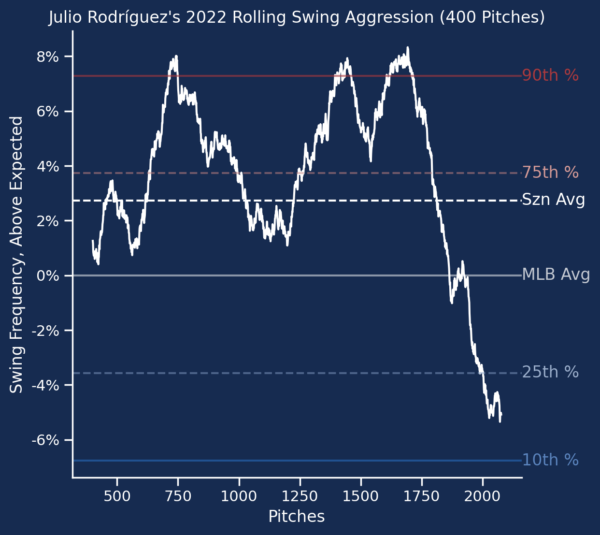
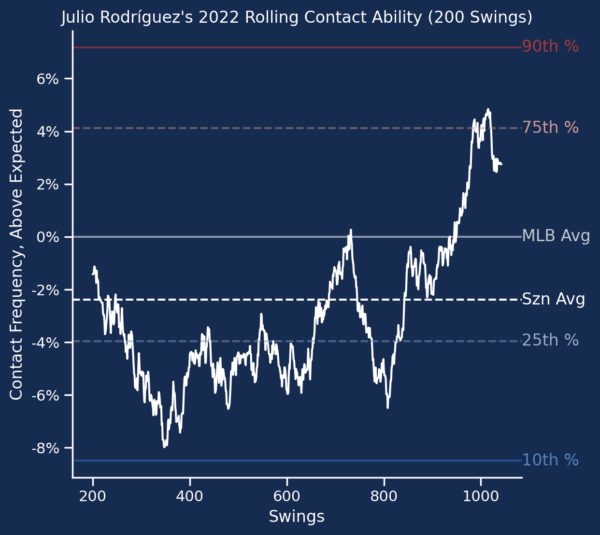
Rodríguez should absolutely be considered as early as pick four or five in all formats, and while there’s just the tiniest hint of risk due to him being a young, inexperienced player, it’s not enough for me to ever try to talk someone out of drafting him.
4. Yordan Alvarez (HOU), OF
I loved seeing Yordan put in a second straight mostly-full season after missing a ton of time due to knee injuries. I had some concerns about whether Alvarez could consistently drive the ball on a pair of bum knees, but 70 combined home runs over the last two seasons are more than enough evidence that he’s feeling just fine. I also loved that Alvarez regained the elite plate skills he showed in his rookie season, walking in 13.9% of his plate appearances while striking out in just 18.9% of them. Those ratios give him an incredible floor with respect to ratios, as evidenced by the .306/.406/.613 line Alvarez delivered in 2022.
His complete and total lack of speed isn’t something that a rule change can fix, and it’s the only reason Alvarez is at the bottom of this tier. Points league and OBP league managers might consider bumping him up a bit if stolen bases aren’t a big impact in your format, though the top of this position is so strong that it’s hard to move just about anyone up inside the top 10 to 15 outfielders.
Tier 2
5. Juan Soto (SDP), OF
Soto had a down year in 2022 with respect to batting average (.242) and RBI (62), though one thing is for certain—Soto still makes the best decisions in baseball when it comes to judging the strike zone and knowing when to swing. I mean, you already knew that, but I’m going to show you a rolling chart anyway just to highlight the fact that his 400-pitch rolling decision value NEVER dipped below the 90th percentile in the league:
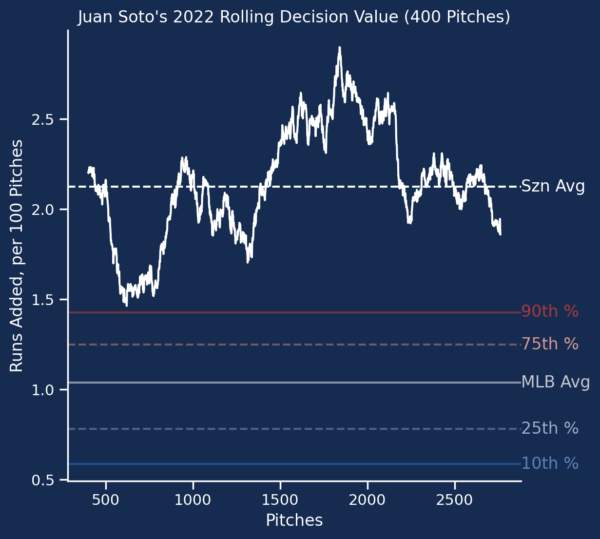
Seriously y’all, that’s insane. Despite the drop in batting average and RBI, Soto still put up 27 home runs and a .401 OBP thanks to his patience and knowing where he can do the most damage. I’m not worried about Soto putting up another dud in batting average—his decision-making is too good to doubt—though I wouldn’t be mad if he decided to be just a little more aggressive at the plate:
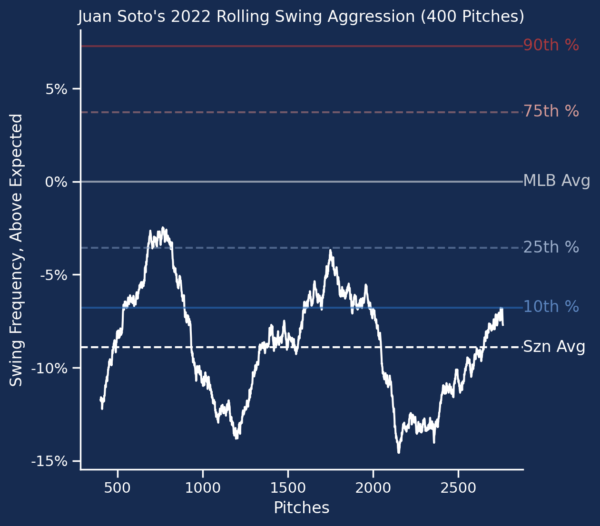
Players with Soto’s bat-to-ball ability and power can generally afford to swing a few more tough pitches than most players, and quite frankly, moving up to the 15th or 20th percentile in aggression wouldn’t really impact his chances at a .400 OBP or anything like that. You’re a big strong dude, Juan, so feel free to swing that bat!
6. Mookie Betts (LAD), 2B/OF
With seven appearances at the keystone, Mookie Betts only qualifies at second base in leagues with the lowest of thresholds. If you happen to be in one of those leagues, though, Mookie is without a doubt the top option at the position and should probably move into the top 10 overall in your league. While there is another player who stands alone at the top tier of their position (José Ramírez at third base), Mookie’s hold on this tier to himself is much stronger and should he qualify at second base again in 2024, it’s all but certain that he’d be alone at the top once again.
For those of you who can’t use Mookie at second base, you’re still getting an excellent player. With the changes to the rules regarding pick-off moves and the size of the bases, Mookie could even eclipse 15 steals for the first time since 2019 to go along with his 30-home run power and 200 or more combined runs and RBI (that are skewed more towards run scored, but you’ll get plenty of both). It’s been a while since Mookie hit .290, and while it’s still within a reasonable range of outcomes, something like .270 is more likely.
Put all of that together, and you have a four-and-a-half to five-category contributor with both a safe floor and a high ceiling.
7. Ronald Acuña Jr. (ATL), OF
Heading into Acuña’s age-25 season, here’s what we know: he’s really fast, he’s really strong, and he gets hurt a lot. If injuries were the only risk for Acuña for 2023, I’d feel really good about possibly reaching for him a bit in drafts, but unfortunately, there’s just a little bit more bad news that gives me the slightest bit of trepidation for Acuña going forward.
Chief among those bad news bears is the 47.7% ground-ball rate and 34% fly-ball rate. Those numbers were basically reversed in 2020 and 2021, and it’s not easy to hit home runs when you’re smashing the ball into the infield dirt half the time. That ground-ball rate helps explain why Acuña only managed 15 home runs in his 119 games after hitting 24 in just 82 games the year prior.
On the plus side, Acuña is still hitting the ball hard and is still judging the strike zone well (as you can see below), so I’m a believer that Acuña can right that launch angle ship in 2023 and get back to providing high-end production in five categories whenever he’s on the field.
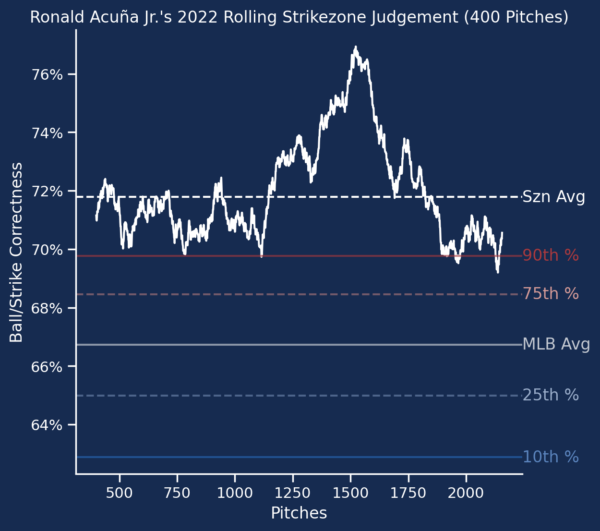
8. Mike Trout (LAA), OF
After the back injury news and missing most of 2021 to injuries, I thought for sure Mike Trout’s 40-home run seasons were a thing of the past, but I apparently forgot that this is Mike Trout we’re talking about here—the Millville Meteor. In just 119 games in 2022, Trout hit precisely 40 home runs with 85 runs scored and 80 RBI. Those are good numbers for a full season, much less one where the guy missed forty games.
Reports so far this offseason on Trout’s rare back disorder have been good, and Trout showed in the second half last season that he can perform at an elite level despite the condition (12 of those 40 home runs came in September). I’m not really concerned about his back condition specifically, which is saying a lot because back injuries are usually a really scary thing. Trout’s injury concerns are still a very real thing, though, and while the routine he has for his back helps him hit, I don’t think there’s a therapy out there that will get Trout back to being a base stealer.
Despite the lack of power and the injury history, I’m still all-in on a guy who has never posted a wRC+ below 160 in any season after he turned 20 (which was back in 2012). Be sure to grab a safe outfielder somewhere else early in the draft if you haven’t already, or at the very least, an extra guy with outfield eligibility in the event you need to cover for Trout for 20-30 games (or possibly more), but otherwise you don’t need to hesitate.
Tier 3
9. Michael Harris II (ATL), OF
Michael Harris II exploded out of the gate and never looked back in 2022 on his way to a 19-home run, 20-stolen base season while slashing .297/.339/.514 over just 114 games. Heading into what will certainly be his first truly full season in the major leagues, I think we can get really excited and expect increases to his production in every single category, and the charts below should help explain why:
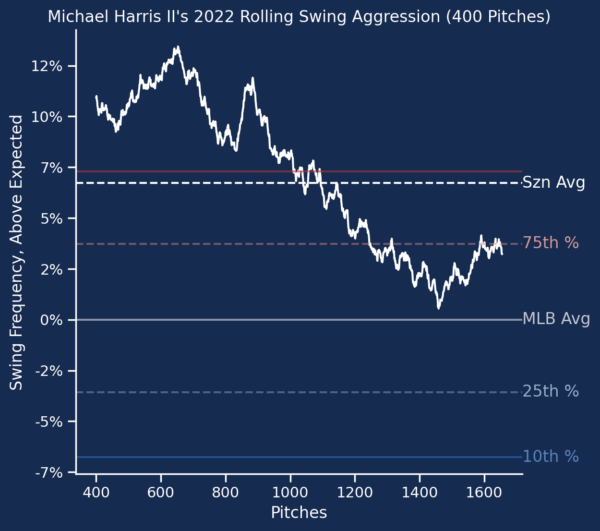
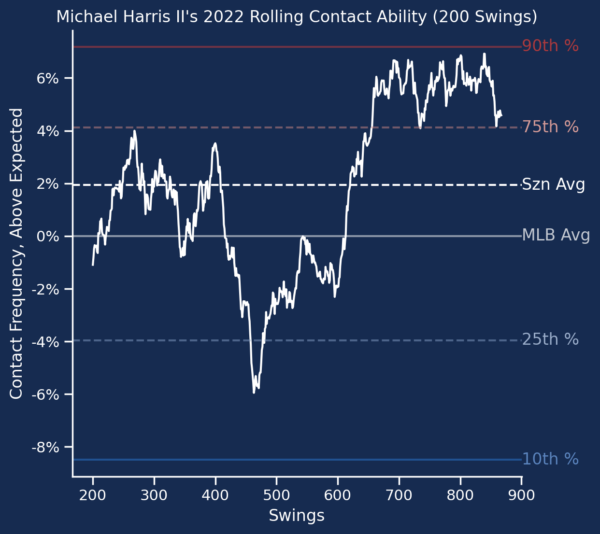
As you can see from the two charts, Harris got a little more patient as the season went on, and as a result, had an easier time making contact with the pitches he chose to swing at. Unsurprisingly, this combination had a very positive impact on his already very impressive metrics:
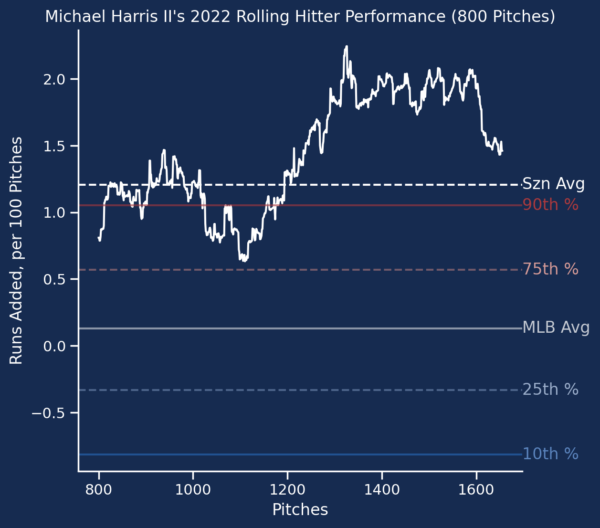
Could there be growing pains for Harris? Sure—there can be for anybody. That said, the combination of his improving patience, elite contact skills, and the fact that he won’t spend a big chunk of the season batting eighth or ninth and will instead be at or near the top of the order should hopefully offset any slumps Harris might run into.
10. Kyle Schwarber (PHI), OF
Schwarber gonna Schwarbs, you know? By Schwarbs, I mean walk a ton, strike out a ton, and mash a ton of dingers. Schwarber is truly a three-outcomes type of hitter, though in his defense, he’s really good at making the two positive outcomes and doing so enough to offset how often he strikes out.
The .218 batting average was pretty brutal in 2022, and that batting average can be partially explained by some bad batted ball luck (his BABIP was 28 points lower than his career mark) and a high fly-ball rate (51.1%). Still, Schwarber hits the ball so dang hard and barrels it so consistently that I feel he should really be closer to a .230 or .240 hitter than a .220 hitter.
Fun fact—Schwarber led off 123 times for the Phillies in 2022, and his career batting average as a leadoff hitter is .224. The addition of Trea Turner to this lineup should mean that Schwarber will no longer need to serve that role. Schwarber’s career average in 861 plate appearances batting second, third, or fourth? A smooth .245.
11. Cedric Mullins (BAL), OF
Mullins fell short of the 30 home runs he surprised us with in 2021 for a variety of reasons, such as the change in dimensions at Camden Yards, reduced barrel and hard-hit rates, and some old-fashioned regression in his home run to fly-ball rate. That’s totally fine, though—Mullins can be an excellent fantasy outfielder hitting 15-20 home runs thanks to his back-to-back seasons with at least 30 stolen bases and a pretty solid batting average floor that shouldn’t go much lower than the .258 we saw from Mullins last season.
And that’s really the whole story for Mullins. There isn’t really much more to ask for out of Mullins besides doing what he did in 2022 again in 2023, and there’s not really anything in his profile to suggest that he’ll have any problem doing that.
12. Adolis García (TEX), OF
Over the last two seasons combined, García has 58 home runs and 47 stolen bases—an elite combination that’s only held back by somewhat limited on-base skills. To his credit, García brought the strikeout rate below 30% and down to 27.9% in 2022 and also added a point to his walk rate, helping him get to a neat and tidy .250 batting average and .300 OBP.
Long term, García’s skill set is likely the type to erode with age, and it will likely erode fast—García will turn 30 before the season begins and it’s just a matter of time before the strikeout rate and stolen bases disintegrate if he doesn’t change his approach. That said, these are redraft rankings, and I’m not worried about how many years García can keep up this aggressive approach—I just care about whether he can do it again for one more year.
Based on the excellent power numbers and upward-trending contact numbers from our lovely PLV stats from last season, I think the answer is yes—García can do this for one more year:
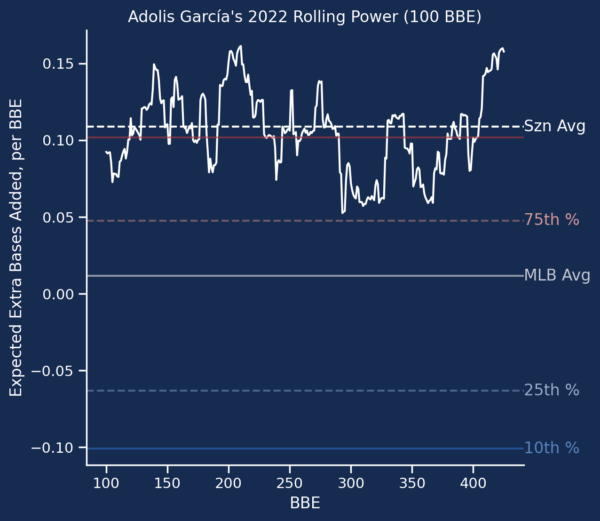
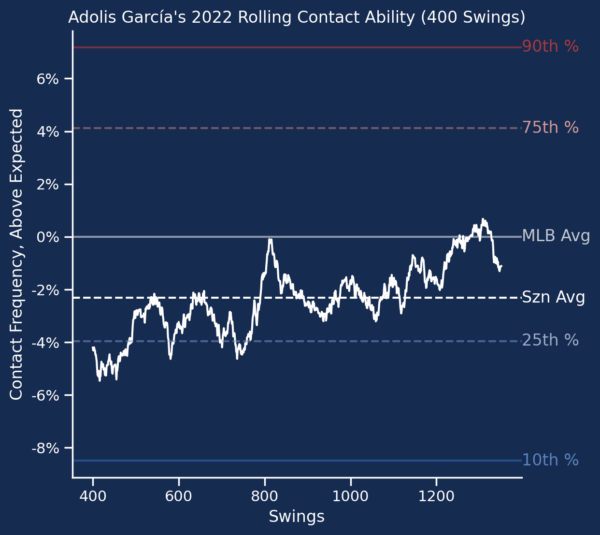
13. Luis Robert Jr. (CWS), OF
Can Luis Robert hit for average? Yes. Can he hit for power? Also yes. Can he steal basis? Yet again, Yes. Can he play 100 games in a season? No idea.
That’s really the whole story for Luis Robert coming into 2023—we know he can hit and we know he can run, we just don’t know how many times he can do that in a season before hitting the IL. Robert, in a full season, should look something like a 25-home run, 15-20-stolen base hitter with a .280 batting average and plenty of counting stats, and those numbers are absolutely worth chasing if you haven’t taken on any injury risk up to this point in your draft.
Robert’s injury risk is pretty extreme, however, and targeting Robert likely takes you out of the Acuña, Chisholm, and Buxton conversations (among others), because it’s just really hard to take on that amount of risk in your first handful of picks.
14. Randy Arozarena (TBR), OF
Thanks to rule changes and team context, Arozarena should be good for another 20 home runs and 25-30 stolen bases in 2023, and I was really happy to see his strikeout rate drop a solid four points from 2021. Strikeouts were the scariest part of Arozarena’s game in years past, and while I don’t expect Arozarena to be a guy who strikes out less than league average, he can still provide a neutral-to-good batting average with average plate discipline thanks to his power and speed.
15. Teoscar Hernández (SEA), OF
While Teoscar didn’t quite live up to his 2021 numbers in 2022, 25 home runs with six stolen bases would make for a pretty good floor heading into 2023. I’m not sure I like the move from Toronto to Seattle—the heart of Toronto’s order has a bit more punch than the Mariners’ lineup, and the park is a bit less friendly in Seattle—but given Teoscar’s natural power and the changes to the rules for stolen bases, he’s definitely still a threat to hit 30 home runs and steal double-digit bases next season.
I have just two concerns for Teoscar heading into 2023. First, and possibly foremost, he needs to make sure not to repeat the 44.1% ground-ball rate from 2022. His profile depends on getting balls up in the air, because that’s the only way to get them over the fence, and he’s not speedy enough to get a meaningful number of infield hits.
Second, I’d love to see Hernández bring that strikeout rate back down to the 24.9% he had in 2021. That four- to five-point reduction in strikeouts goes a long way for Hernández as he’s not the type of player to take a walk. It’s his best path to a .270 or better batting average, and if that strikeout rate climbs into the thirties, things could get really ugly really quick.
Tier 4
16. Eloy Jiménez (CWS), OF
Like his teammate Luis Robert Jr., Eloy has major injury concerns. He’s only played in 139 games in the last two seasons combined, and even with 30-home run potential in his bat, that’s just not enough playing time to provide meaningful fantasy contributions.
On the bright side, what we did see from Eloy in 2022 was quite good—he was definitely on pace to get to 30 home runs, and his .295/.358/.500 line along with a career-best walk and strikeout rate gives us hope that if we do get a full season from Jiménez in 2023, we can see something like a slightly lesser version of Yordan Alvarez. That’s the upside you’re shooting for when you draft Eloy, but keep in mind that the downside is a guy who plays 50-80 games with quite variable ratios due to the smaller sample size.
17. Starling Marte (NYM), OF
Marte is coming off core muscle surgery this offseason, and some reports suggest he may be limited to start Spring Training. Don’t panic, though—a veteran like Marte can do just fine with a slow start to the Spring provided that he’s healthy.
It was disappointing to see Marte steal just 18 bags in 2022 after stealing a mind-blowing 47 bases in just 120 games (including 25 steals in just 56 games while he was with Oakland), especially because he got caught in a third of his attempts (his career rate is considerably better).
While Marte shouldn’t have any issues matching the 16 home runs or .292 batting average from a year ago, his odds of stealing 20 or more bases hinge on his health (which was likely a critical factor in his poor success rate in 2022), and a healthy Marte equipped with a few helpful rule changes would not surprise anyone if he stole 25-30 bases for the Mets.
18. Byron Buxton (MIN), OF
I’ll keep this blurb short because you already know the drill here—Buxton is an elite contributor when he’s on the field, but the last time he played 100 games in a season was 2017—and it’s the only time he’s ever played 100 games at the MLB level in his career. If healthy, Buxton would probably look like a 35-40 home run hitter with 10-15 stolen bases, albeit with a .230 to .240 batting average. That player would rank considerably higher than this one, but of course, we’ve never actually seen this power-hitting version of Buxton for more than 92 games at a time, so it’s hard to gauge exactly how to handle him.
I’m not saying you can’t target Buxton in drafts. In fact, I love the idea! The thing is, though, that if you draft Buxton you need to make sure you heavily hedge your bets for power and in the outfield in the event that Buxton misses 60 or more games like he has in basically every season of his career.
19. George Springer (TOR), OF
Springer is sort of like a muted version of Byron Buxton, honestly. He puts up good power numbers, could threaten double-digit steals, and has dealt with a litany of injuries in the past few seasons. While he doesn’t have Buxton’s 40-home run upside, Springer is a much better bet to hit 25 home runs than Buxton simply because he’s far more likely to play in 120 games.
As a full-time player at the top of the Blue Jays’ batting order, Springer should provide a healthy amount of power, runs scored, RBI, and OBP along with a pretty decent batting average and not-insignificant speed. He’s a well-rounded contributor who, if you can look past the fact that he’s likely to miss 20-40 games in any given season, can be a valuable addition to your roster without requiring you to take the leaps of faith that other players in Tier 3 and Tier 4 require.
20. Bryan Reynolds (PIT), OF
I’m ranking Reynolds with the assumption that he stays a Pirate for the entire season mostly because I don’t think the Pirates are smart enough to do something smart like trade him, but even in the pitching-friendly confines of gorgeous PNC Park, Reynolds is basically a lock for 24-26 home runs and a pretty good number of RBI and runs scored hitting in the middle of the Pirates order, particularly if guys like Oneil Cruz and Ke’Bryan Hayes can put up seasons that resemble their levels of natural talent.
A trade for Reynolds to a team like the Yankees might bump him up a little bit in this tier, but what would really give him a boost is a return to a sub-40% ground-ball rate like he had in 2021, or better yet, a better ground-ball rate and a slight reduction in strikeouts to get below 20%. That kind of combination could take him from a .265-.270 hitter to more like a .285-.290 hitter, and that’d be pretty darn neat.
21. Corbin Carroll (ARI), OF
I love using rolling charts with rookies, and while Carroll is one of the most promising young outfielders in the game, nothing I saw in his rolling charts gave me something fun to hang my hat on like I had with guys like Vinnie Pasquantino or Oneil Cruz.
Instead, if you want to buy in on Corbin Carroll, you’ll do so because you believe in the scouting reports that suggest he has the ability to be a plus in four to five categories as soon as 2023 now that he’s slated to be with the big league team for the full season, and because he’s a legitimate threat to be a 20-home run, 20-stolen base type of player in the mold of Michael Harris II. There’s risk in the profile due to his unproven track record above Double-A, but if you’ve got room to gamble and want to do so on an outfield prospect, this is the one to go for.
Tier 5
22. Taylor Ward (LAA), OF
It was a tale of two Wards last season—the healthy one and the not-healthy one. The healthy one showed up in the early and late parts of the season, while the injured version stuck around in the middle. To see what I mean about how there were two Wards, please refer to the rolling charts below:
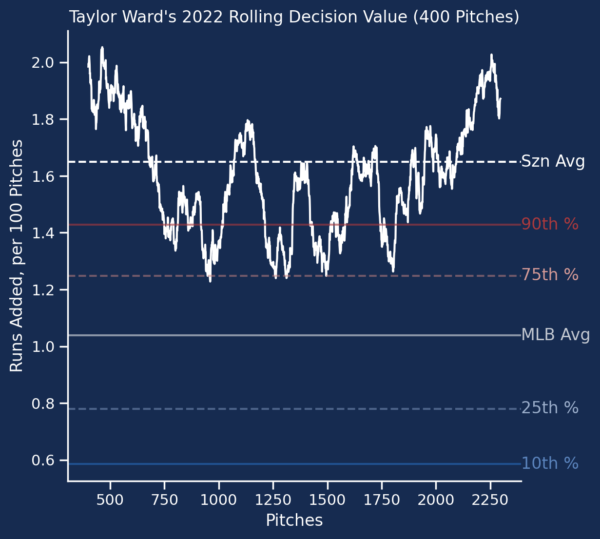
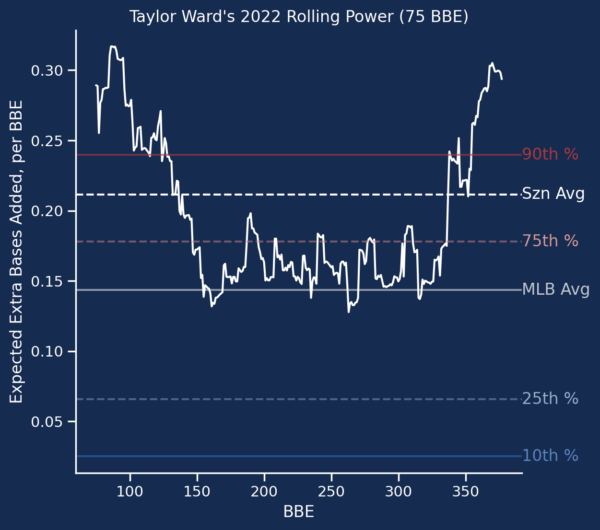
As you can see, the healthy Ward made excellent decisions and showed off top-notch power, while the injured Ward had more average power and was slightly less adept at making good decisions, likely due to compensating for the injuries he battled through.
Despite the injured Ward eating up most of Ward’s overall at-bats, he still hit 23 home runs with a .281/.360/.473 line. It’d be awfully bold to say Ward could surpass all of those numbers in 2023 if he can stay healthy, and I suppose I just said it.
23. Seiya Suzuki (CHC), OF
In his first year on this side of the pond, Suzuki only managed to play in 114 games and had a somewhat pedestrian .262/.336/.433 batting line with 14 home runs and nine steals. If that’s Suzuki’s true talent, then there wouldn’t be all that much to get excited about, but once again the rolling charts add some context that gives us a lot of hope that Suzuki was making adjustments and reading the zone better as he saw more and more MLB pitches:
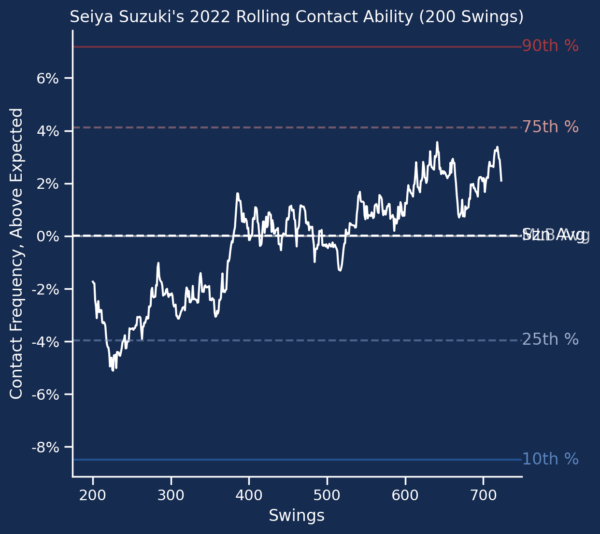
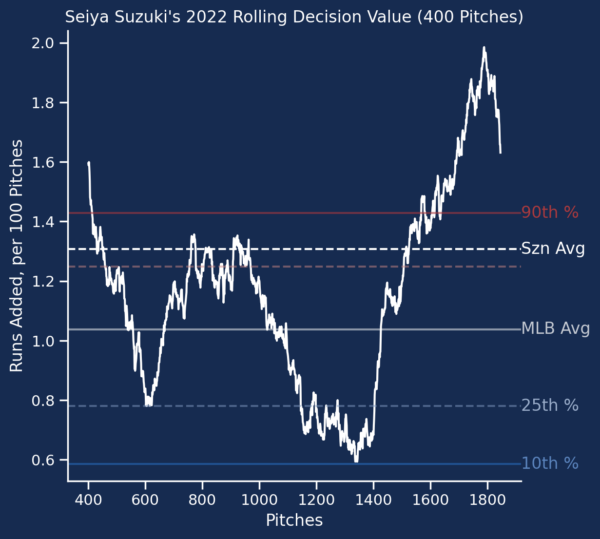
Assuming Suzuki can build on this type of growth—and I firmly believe he can—I think Suzuki could be a 22-25 home run hitter who steals 10-12 bases with above-average ratios across the board. Also, because he’ll be batting in the middle of the Cubs’ order, Suzuki should still have a shot at 80 or more runs and RBI as well. Of course, he’d need to stay healthy and continue to grow, which is a tall order for any player, especially one who is going into just his second MLB season, but there’s a real shot for impactful production there that you might not want to have pass you by.
24. Steven Kwan (CLE), OF
I think these two charts tell a pretty compelling story about the type of player Steven Kwan is:
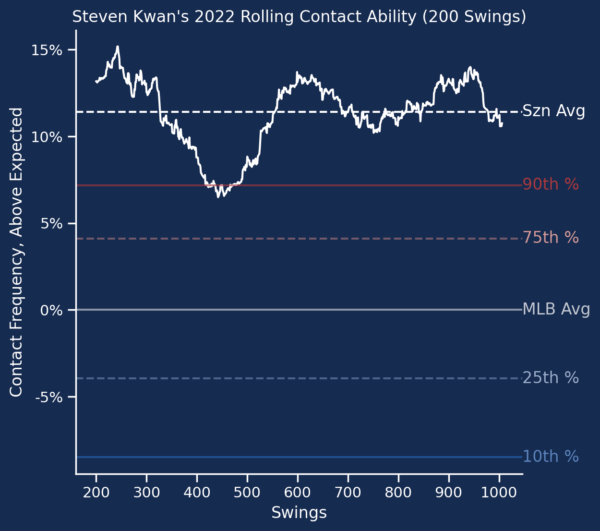
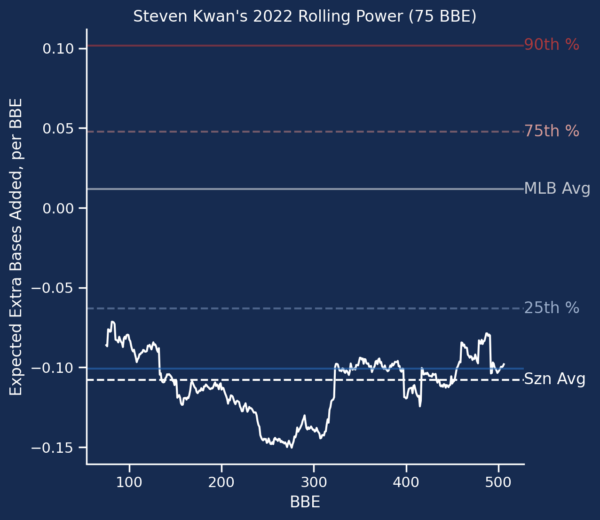
As you can see, Kwan is a guy with an amazing hit tool and very suspect power, which bears out in his stat line as he hit just six home runs with a .298 batting average in his rookie year. What differentiates Kwan from guys like Luis Arraez and Jeff McNeil, though, is that Kwan also has the speed to steal 20-25 bases at the top of the often-aggressive Guardians offense.
I still think it’s possible that Kwan becomes something like the good version of Whit Merrifield (10-12 home runs, 25 or more stolen bases); even if the home run totals don’t hit double-digits, the run scoring, batting average, and stolen bases do enough to justify Kwan as a high-floor player in this tier.
25. Daulton Varsho (TOR), C/OF
Varsho’s rank would be quite a bit lower if he wasn’t catcher-eligible, but catcher eligibility is one of the few positional eligibilities that will get me to move a player up my board. Varsho had a breakout in 2022, hitting 27 home runs and stealing 16 bases for the Diamondbacks, and now that he’s a member of the Blue Jays, I think we can expect a bit more than the 79 runs scored and 74 RBI as an everyday player on a much better offense.
Yes, the batting average was a bit of an eyesore at .235, and I don’t expect it to be much better than that in 2023 as he doesn’t hit the ball particularly hard most of the time (35.3% hard-hit rate), but a speedy, powerful catcher does a lot of good for a fantasy team, and in head-to-head category leagues, the poor batting average is less of a burden as batting average is inherently fluky from week to week. Some weeks Varsho’s average will hurt you, but there will always be weeks that it helps as well.
26. Kris Bryant (COL), OF
A healthy Kris Bryant in Colorado could definitely be a guy who hits 27-29 home runs with a .300 batting average, though with health issues significantly limiting Bryant’s playing time in three of the last five seasons, it’s probably smarter to hedge your bets a little on Bryant and project closer to 20-25 home runs. Bryant will likely take a beating on the road due to that pesky Coors effect, but I think there’s just enough to this lineup (especially when they are at home) to turn Bryant back into a very relevant fantasy player right away if he is at all healthy.
Tier 6
27. Giancarlo Stanton (NYY), OF
In the seven seasons from 2014 to 2022 where Stanton has played at least 74 games, he’s hit at least 27 home runs, and he usually does so with a high walk rate and a surprisingly decent batting average for a guy who is prone to striking out 30% of the time. Stanton should be good for at least 27 home runs again in 2022, though you need to be ready for him to miss anywhere from 25 to 50 games due to whatever new injury pops up during the course of the season.
I like grabbing Stanton on teams that are a bit light on power but have a few outfielders on the team already (for example, if I’ve drafted Kwan, Marte, or Mullins). Despite the injury risks, Stanton remains as reliable as they come for power, and some might do the dreaded double-discount when they look at his games played, meaning they’ll look at a projection that already considers the fact that he’ll miss a bunch of time, then lower that projection again because they consider him a high injury risk. Don’t do that—if the projection already bakes in a lower projected games played total, don’t make a second adjustment for risk.
28. Jake McCarthy (ARI), OF
If I told you before the 2022 season began that a rookie outfielder from the Diamondbacks would take the fantasy community by storm in the second half of the year, there is a 0.001% chance you’d correctly guess which rookie outfielder I was talking about. McCarthy came out of nowhere to steal 23 bases and hit eight home runs over 99 games, with basically all of that production coming after August 1st. 20 of those stolen bases were in the final two months of the season, when he smacked five home runs and hit for a high average as well.
McCarthy was not a heralded prospect and probably wasn’t considered a top-20 prospect for Arizona by any major publication. Nevertheless, he’s an intriguing young outfielder with a ton of speed. He’s not without potential warts, however:
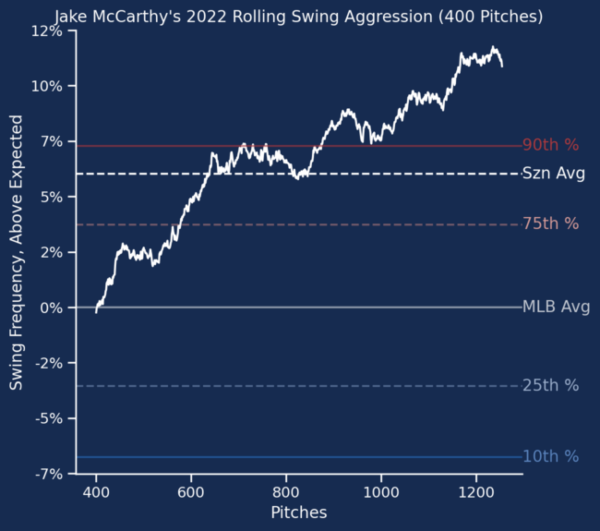
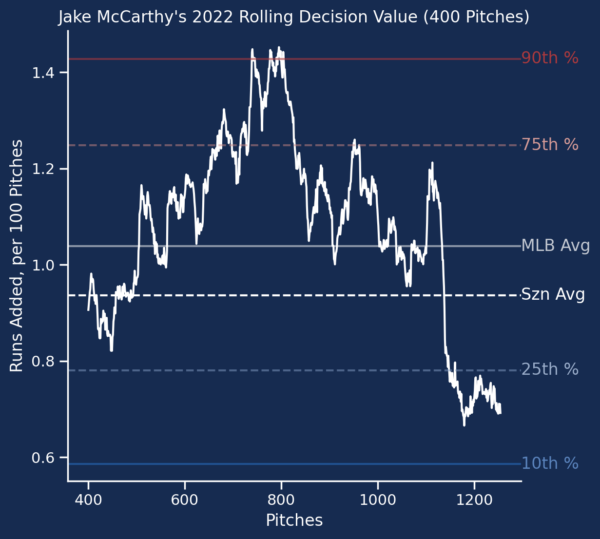
As you can see, McCarthy became more aggressive as the season went on, and while the performance stayed strong, our model did not love the decision-making going on right at the end. While this may just be a blip on the radar, it does help remind us that McCarthy comes with a lot of risk and is a better target in roto leagues where those stolen bases help offset any potential hit to batting average or power that come in his second season.
29. Anthony Santander (BAL), OF
While seemingly every Oriole took a step back in power in 2022 thanks to the dimension changes at Camden Yards, Santander did the opposite by nearly doubling his home run totals from 2021 to 2022, ending with 33 home runs in 152 games. There’s nothing terribly complicated about Santander’s game. The 28-year-old outfielder likes to hit balls in the air and he likes to hit balls hard. Most of all, he likes to do both at the same time.
The only reason I hesitate to project another 33 home runs for Santander is that 10 of those home runs came in September, and it’s hard to ever project a player to hit that many home runs in one month. While Santander does have very real power, I might pull back just a touch on that projection and keep him closer to 28-30 home runs if only because that 10-home run month in September will almost certainly go down as the most he’ll ever hit in a single month in his career.
That said, he also may have been a little unlucky in the batting average department, and some general improvements to the Orioles offense just by virtue of natural regression for guys like Ryan Mountcastle could help push his counting stats up just a bit, so while I’m splitting hairs a little with the power projection, his overall value should remain quite similar to what we got from Santander in 2022.
30. Christian Yelich (MIL), OF
Constant back issues have plagued Yelich for a few seasons now, but 2022 was the first time since 2017 that he managed to play 150 games in a season, ending the year with 154 games played, 99 runs scored, 57 RBI, 14 home runs and 19 stolen bases.
While Yelich was once considered a big-time power hitter back in 2018 and 2019, injuries and changes to the league’s offensive environment make that no longer part of our reality. These days, Yelich presents as more of a 15-20 home run bat who still has some decent speed (especially with the new rules coming into effect) and who still takes plenty of walks (13.1% walk rate in 2022).
I suppose a little bit of health luck and batted-ball luck could get Yelich back to being a 20-home run threat for the first time since 2019, but even if it doesn’t, accepting Yelich as a guy who can get you 15 home runs and 15 stolen bases with upside for more on both and a high OBP is enough to consider drafting Yelich in most formats.
31. Nick Castellanos (PHI), OF
After finally seeing the power break out in 2021 for Castellanos, the home runs all but vanished for Nicky C in 2022 as he hit just 13 of them in 136 games. I can’t figure out exactly why Castellanos was so much worse on fly balls in 2022 than he was in years past, but it was certainly the case—his OBP on fly balls in 2022 was nearly half of what it was in 2020 and 2021 despite hitting them with similar frequency.
The one thing I can say for certain is that the change in home ballpark from Cincinnati to Philadelphia wasn’t the root cause—even if Castellanos had played all of his games in Great American Ballpark, he’d have hit just 19 home runs compared to the 34 he hit in 2021.
It’s always troubling when I can’t find a root cause of such a severe issue. On one hand, Castellanos has always possessed a good hit tool and has never really slumped like this for too long, so there’s hope that he can turn this around by tweaking whatever it was that broke over the offseason. Considering that I have no idea what it is that broke, though, it’s hard to get overly optimistic that he can return to being a guy who can hit 30 home runs.
The folks behind projection systems like THE BAT and ATC have Castellanos hitting 20-22 home runs this season with a good batting average and plenty of counting stats, and if true, this ranking is still pretty good. Additionally, the upside for more power is there based on what we saw from him in 2019-2021. I’ve got no qualms with drafting Nick Castellanos and hoping he turns things around—just don’t ask me what was wrong or how to fix it.
32. Tyler O’Neill (STL), OF
Chasing power and speed isn’t a bad thing, and Tyler O’Neill showed he still has plenty of both despite playing in just 96 games last season by hitting 14 home runs and stealing 14 bases. Sure, it came with a .228 batting average, but at least the underlying power and speed were still there despite the injury.
I wouldn’t be taking a guy like O’Neill if I already took gambles in my outfield like Luis Robert or Byron Buxton, but if I had played it safe until now, I’d absolutely take the chance on O’Neill and the upside of 30 home runs and 20 stolen bases, especially after seeing him lower his strikeout rate from 2021 to a more palatable 26.9%.
33. Hunter Renfroe (LAA), OF
Hunter Renfroe isn’t a complicated hitter—he likes to swing the bat really hard and hit pulled fly balls into the bleachers. It’s a safe, steady combo that has led to at least 26 home runs in each season where he’s played at least 100 games in the major leagues.
Renfroe has done good work to lower his strikeout rate over the last few seasons as he’s bounced from San Diego to Tampa Bay to Boston to Milwaukee and now finally to LA, and that improvement has helped raised his batting average floor from .230 or so to something more like .240 or .250. Hitting behind guys like Ohtani and Trout should do wonders for his counting stat totals, and while injuries tend to chip away at his games played each season by a little, it’s not enough of an impact to change where I’d consider drafting him.
Renfroe isn’t really an upside play, but he’s steady power that won’t crush your ratios at a point in the draft where guys who can do that are starting to run out. If you need power in the middle rounds of your draft, Renfore is as good a target as any.
34. Brandon Nimmo (NYM), OF
Nimmo isn’t going to be invited to the Home Run Derby any time soon, but it was great to see him put up the first 150-game season of his career and just his second season with 140 or more games played. That playing time is critical to a player like Nimmo who specializes in simply getting on base however he can.
What separates Nimmo from his teammate Jeff McNeil is that Nimmo can hit 15-17 home runs and leads off for an offense that should continue to score plenty of runs, giving him the opportunity to possibly repeat the 102 runs scored he put up in 2022. While Nimmo won’t quite compete for a batting title, he should have no problem hitting at least .270 or so (if not better), and his double-digit walk rate keeps his OBP floor extremely high for folks who play in formats that reward that kind of thing.
The injury risk and lack of speed put a bit of a cap on Nimmo’s projectable ceiling, but even without pristine health or a swath of stolen bases, Nimmo provides steady contributions in ratios and runs scored with just enough power to give you a boost. If your league-mates find that to be too boring and let him fall in drafts, be sure to pick him up before they realize their error.
35. Andrew Vaughn (CWS), 1B/OF
Another mostly full season, another season of Vaughn falling short of 20 home runs. While we did see improvements in his batting average (he hit .271 in 2022), the lack of power and counting stats has been rather disappointing from the third overall pick in the 2019 draft.
Perhaps the most frustrating of Vaughn’s underlying issues is how passive he is on pitches in the zone and how aggressive he is on pitches out of the zone. His 63.2% swing rate on pitches in the zone was the 18th-lowest among 130 qualified hitters last season, while his chase rate of 35.5% was the 34th-highest. Ideally, a player with Vaughn’s skillset would have those rankings flipped—Vaugh should be swinging at a lot of pitches in the zone and laying off the stuff out of the zone. This concept bears itself out in our PLV stats as well, as Vaughn really struggles to judge the zone, and as a result, tends to make worse-than-average decisions.
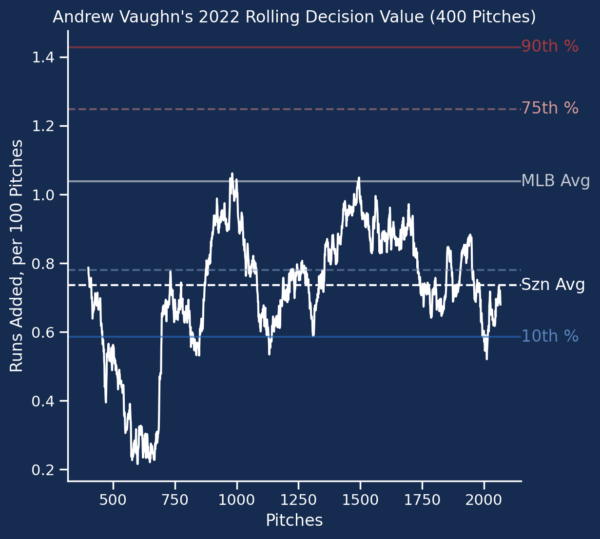
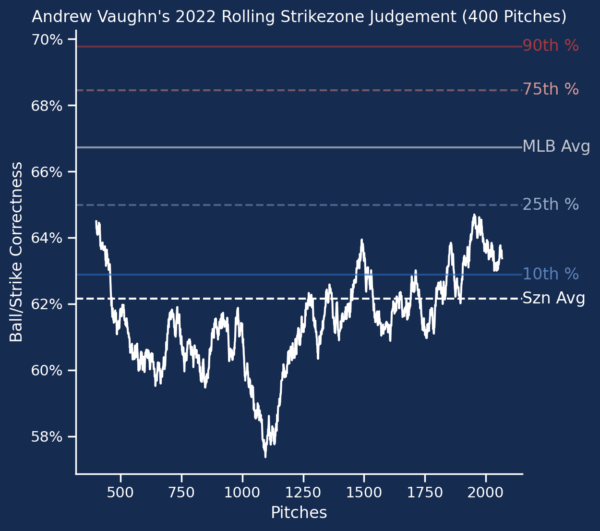
If there is any consolation, it’s that Vaughn DID improve his power output as 2022 went on, and since I dropped two sad charts above, I suppose I can end with a happy one:
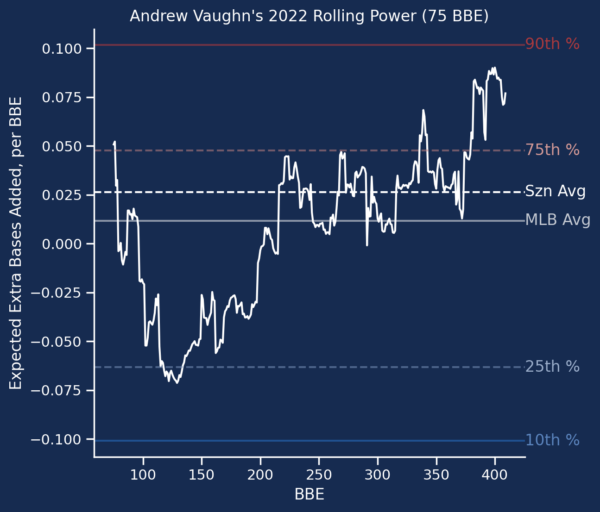
Tier 7
36. Amed Rosario (CLE), SS/OF
Amed Rosario doesn’t walk and doesn’t hit for much power (he has just 11 home runs in each of the last two seasons), but putting the ball in play has led to back-to-back seasons with a batting average better than .280 and 31 combined stolen bases. Rosario is also quite durable heading into his age-27 season, having played at least 141 games in each season since becoming a full-time player for the Mets in 2018.
There isn’t much ceiling to be found for Rosario, as he’s not very good at barreling the ball and hits almost twice as many grounders as he does fly balls, but Rosario’s propensity for spraying the ball to all fields and Cleveland’s willingness to give Rosario the green light means he should be able to get to continue putting up double-digit home runs with 15-20 stolen bases and a decent batting average. It’s a great floor for deeper leagues, and his outfield eligibility is fairly useful, particularly in leagues requiring five starting outfielders.
37. Ian Happ (CHC), OF
Happ’s low-20s home run power and 10-12 stolen bases (assuming he gets a lift from the new rules) with his volatile batting average (which took a big step forward in 2022) wouldn’t normally feel like a top-40 outfielder, but Happ benefits greatly from the fact that the Cubs need him to bat third in this lineup, giving him an ideal position to pile up counting stats that a player with his skill set normally can’t attain.
Sure, names like Nico Hoerner, Dansby Swanson, Seiya Suzuki, and Eric Hosmer don’t strike fear into the hearts of opposing pitchers, but that collection of players should get on base enough to give Happ the chance to drive runners home and also bring him around as well. A move to the bottom half of the order on this team (or really any other team) would lower his ceiling considerably, but for right now, Happ is a guy who can accumulate his way into a fantasy manager’s heart.
38. Lars Nootbaar (STL), OF
Fun story—when I referenced Lars Nootbaar to my boss in my day job as the type of guy the Cardinals find out of nowhere that becomes interesting, he honestly thought I was making up his name for comedic effect. I wasn’t, of course, but if I was to make up a name for comedic effect, it might sound something like Lars Nootbaar.
Anyway, Nootbaar showed off some interesting developments and skills in his 108 games in the majors, hitting 14 home runs with a 14.7% walk rate and 20.5% strikeout rate. While the batting average was a less-than-exciting .228, his .340 OBP and improving contact ability (see below) give me hope that he can improve that batting average and turn into a 20-22 home run type of player with five to seven stolen bases and an excellent OBP.
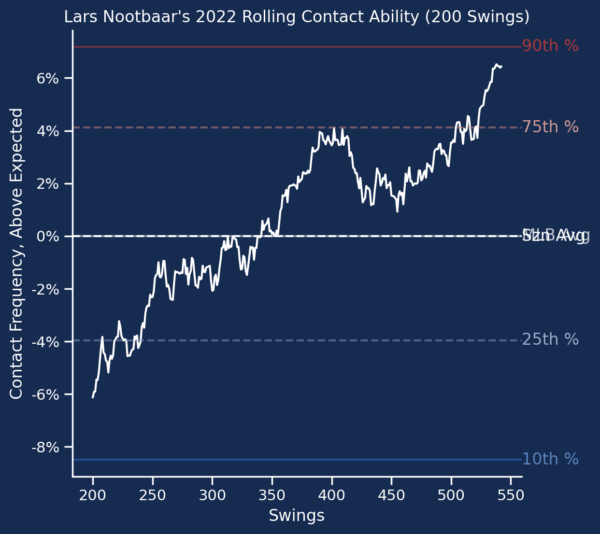
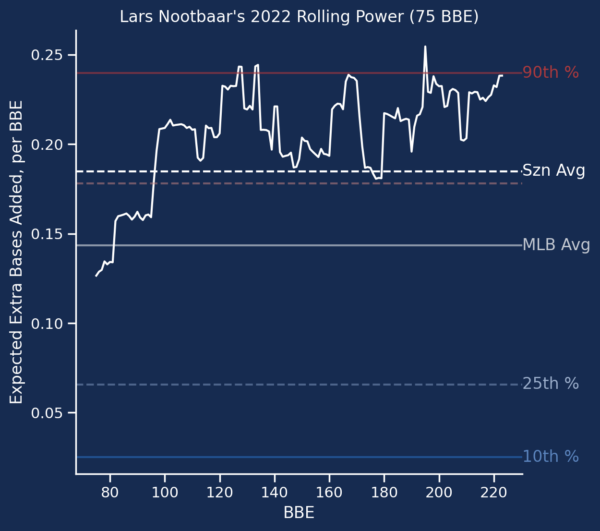
In a perfect world, Nootbaar can find his way into the top two spots in the lineup and become a Brandon Nimmo-like player with a bit less average and a bit more pop, and his plate discipline and debut were good enough that I’m willing to pay a bit of a premium to get a chance at that upside.
39. Alex Verdugo (BOS), OF
Verdugo has hit at least .280 in each of the last five seasons, and while he may never hit more than 15 home runs, he should continue to bat near the top of the order for the Red Sox, which helps to maximize the value you can get from his batting average. I wish I had more to say about a guy going into his age-27 season who was once a highly-regarded prospect, but 1,957 plate appearances have given me a lot of information on Verdugo, and unless he does something that doesn’t follow the script he’s followed for his entire professional career, you can feel pretty confident that what you’ve seen is what you’ll get.
40. Mitch Haniger (SFG), OF
If you told me you were from the future and that you knew Mitch Haniger would get to 140 or more games played in 2023, Haniger would be near the top of this tier. While his batting average is likely to sit between .240 and .250, Haniger has enough power to hit at least 25 home runs in a full season with the upside to hit 30 or more (though the 39 he hit in 2021 is almost certainly above his projectable ceiling).
Of course, Haniger has only played more than 140 games on two occasions—once in 2018 and one in 2021—and he’s played in 70 or fewer games in 2019 and 2022 while missing the entire 2020 season. Needless to say, Haniger’s plus power and propensity for driving in runners come with enormous health risks.
If you missed out on guys like Santander and Renfroe at the top of this tier and find yourself in dire need of home run upside, Haniger has you covered. Well, maybe. You know, if he actually plays most of the season.
41. Thairo Estrada (SFG), 2B/OF
Thairo Estrada is one of those who just did a little bit of everything in 2022—a bit of pop, more than a bit of speed, decent ratios, and more than his fair share of runs and RBI. While none of his statistical contributions will wow you on their own, their cumulative value was enough to sneak into the top 10 at second base last season when all was said and done.
Estrada appears to be the front-runner to leadoff for the Giants, and while that offense isn’t exactly fearsome, there’s just enough thump behind him in the order to believe that he can notch 80 runs if he plays most of the season. If you combine that with the rule changes that promote speed and the fact that the Giants will likely find themselves in a position where they need to manufacture runs on the regular, a 15-home run, 20-stolen base season seems more than reasonable. That power and speed, along with 80 runs scored and a .260 batting average, come together to be a back-end starter at second base in 12-team formats, albeit one with a bit of a lower ceiling than others in this tier.
42. Bryce Harper (PHI), OF
Ranking a guy who is going to miss half the season is hard no matter what their talent level is, but it’s even harder when it’s a guy you know you can’t just let sit on the waiver wire in leagues that have an IL. Harper managed to play in 99 games in 2022 due while dealing with injuries, and despite the less-than-stellar health, he hit .286/.364/.514 with 18 home runs and 11 steals—enormous totals for a short season.
I’m not terribly concerned about how well Harper will play when he gets on the field, I just also know that it’s a long time from now until the All-Star Break when he’s projected to return, and any setback could jeopardize his fantasy season. I’m not sure you can necessarily draft Harper in leagues that don’t have an IL for injured players, but for leagues that do, I think he’s worth drafting for the upside and impact he should have in the second half.
Oh right, and one other thing—teams don’t have to put a guy on the IL right away, so be careful how many players you draft that you plan to plug into your IL, as you may not be able to add all of those guys to your IL until games are starting. Harper is likely to be on the 60-day IL so that his team can open up a spot on the 40-man roster, so it shouldn’t impact him, but this was also the most obvious place to mention this little quirk about how teams use the IL prior to the start of the season.
43. Andrew McCutchen (PIT), OF
While Cutch is no longer a contributor to batting average nor is he an elite OBP provider like he was at his peak, he can still hit high-teens home runs and steal close to double-digit bases heading into his age-36 season. If swag is a category in your league (which it should be but probably isn’t), Cutch would fly up these rankings, but as we’re all stuck with more conventional stats, we should probably plan more on the 15-18 home runs, 8-10 steals, and 140-150 combined runs and RBI he’s likely to pile up as part of the Pirates.
Cutch won’t be considered an exciting pick on draft day, but if you’re looking for a high-floor outfielder who can contribute a bit to all categories, don’t overlook McCutchen.
44. Masataka Yoshida (BOS), OF
It can be tough to get a feel for players from Japan and how they’ll perform in the US, but if projection systems are to be believed, we could be looking at a guy whose stats closely resemble Brandon Nimmo (albeit with fewer runs scored because of batting order and supporting cast). If I was to compare Yoshida to one of his own teammates, simply in terms of fantasy output, it would be something like Alex Verdugo, though with Verdugo I know what I’m getting and with Yoshida I’m taking a bit of a leap of faith.
Points league players can afford to take more of a gamble on Yoshida as he’s likely to take plenty of walks and put a ton of balls in play—an ideal skillset for that format, while the rest of us playing in categories leagues may have to be a bit more conservative due to the risk that he struggles and drops to the bottom third of the Red Sox batting order, which would all but crush his potential value.
45. Joey Meneses (WAS), 1B/OF
Joey Meneses came out of nowhere in 2022 to hit 13 home runs and bat .324/.367/.563 with a 156 wRC+ over 56 games as a 30-year-old rookie. We’ve been burned by players like this in the past (Frank Schwindel comes to mind), but a few of our PLV metrics are rather bullish on Meneses:
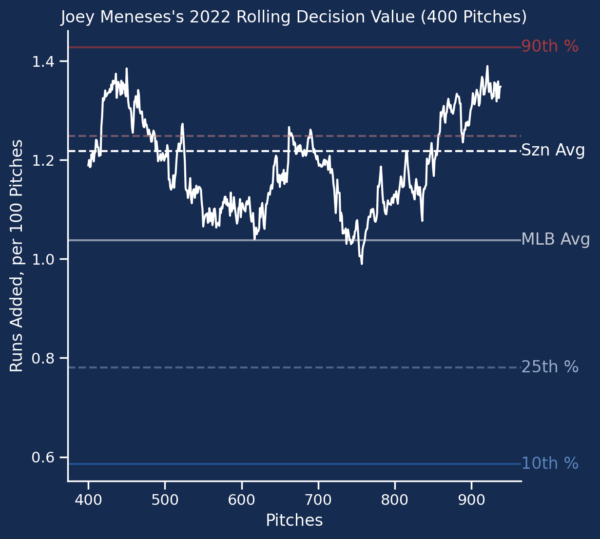
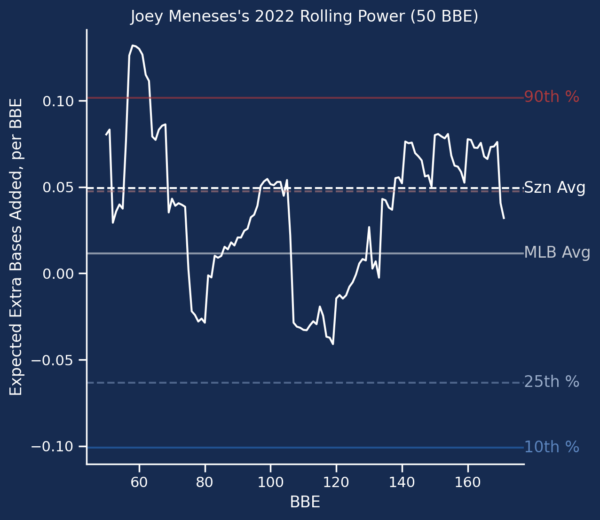
In short, a player with excellent decision-making in the batter’s box with above-average power is a player worth monitoring, and while he’s more likely to wind up as one of your outfielders than your first baseman, there’s more than enough here to consider taking a shot on Meneses late in drafts.
46. Jeff McNeil (NYM), 2B/OF
McNeil’s breakout campaign in 2019 probably gave us the wrong impression about what to expect from McNeil in the power department—the 23 home runs in 133 games that season are as many as he’s hit in the 433 games he’s played in 2018 and 2020-2022. Instead, McNeil’s profile is incredibly similar to Luis Arraez. McNeil’s .326 batting average, 10.4% strikeout rate, nine home runs, and four stolen bases could just as easily have been Arraez’s stat line last season, though the one key difference between them is lineup placement.
Arraez is slated to lead off in Miami while McNeil looks to be batting fifth. While batting fifth provides more RBI opportunities (especially when you consider the supporting cast in New York compared to Miami), it does reduce the number of runs scored and plate appearances McNeil can rack up. I much prefer players like this to be at the top of the lineup so that they can maximize the fantasy value of their slap-hitting ways, but it’s hard to complain too much about a player who will compete for a batting title.
47. Lourdes Gurriel Jr. (ARI), 1B/OF
Gurriel finds himself in a new home in Arizona, and while the supporting cast isn’t nearly as good as the one he left behind in Toronto, at least this new gig comes with a more prominent role in the starting lineup.
Unfortunately, Gurriel’s barrel rate plummeted in 2022 to a puny 3.8% as he hit just five home runs and stole only three based in 121 games last season. Sure, it came with a .291 batting average, but I’m not a big enough believer in Gurriel to expect him to make that kind of profile work in the way it does for Jeff McNeil or Luis Arraez.
While he’s certainly worth looking at as a late-round pick, Gurriel needs to find a way to get the ball in the air with more authority to ensure more than 4.2% of his fly balls turn into home runs, even if he has to sacrifice batting average to do it. He hit 21 home runs in 2021, so it’s not as though he’s never done it before, though if the power is still absent a few weeks into the season, I won’t hesitate to move on.
Tier 8
48. Cody Bellinger (CHC), OF
A change of scenery could do wonders for Bellinger, whose .210/.265/.389 batting line was actually a significant improvement over what he did through 95 games in 2021 while still on the Dodgers. It’s hard to point to a single cause for Bellinger’s extreme decline, though this article by Jeff Zimmerman does suggest the issue may have been the shoulder surgery he had back in 2022. If the injury and subsequent recovery are the cause, then a change of scenery won’t really help much as the problem would be with his body, not his brain. On the other hand, there’s no reason Bellinger can’t do a bit of reinvention as a hitter.
Oddly enough, our metrics suggest that his issue isn’t making contact, despite his horrible batting average in each of the last two seasons, and it’s not as though he’s far below league average in power, either:
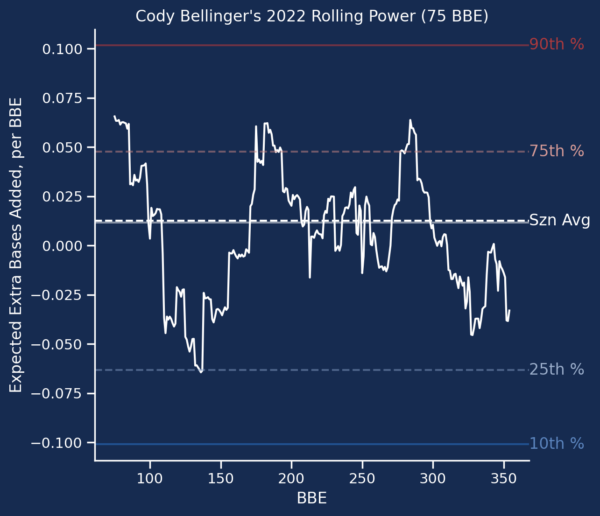
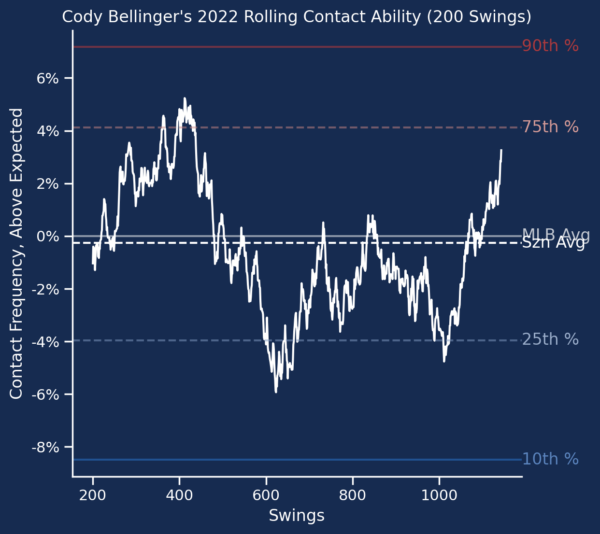
In fact, none of our metrics point to an easily-identifiable cause. Had the issue been solely his injury, I would have expected to see his power crater as we saw with guys like Max Muncy, but instead, he seems to be a pretty average hitter (with respect to power and contact) putting up extremely below-average results.
Being unable to point to a clearly identifiable cause, I’m forced to consider Bellinger more of a lottery ticket than anything else. True, his power and speed production, provided he plays a mostly full-time role, should be somewhat predictable, something like 20 home runs and 15 stolen bases, though the Bellinger of old suggests that there still might be upside for 25 or more home runs if he can figure out what’s causing him to be so mediocre of late. That said, his ratios have such a low floor that despite all that pop and speed he may still be irredeemable in 12-team formats.
For baseball’s sake, I hope Bellinger can go back to being a force on the diamond, as he’s only 27 years old and should have more prime years ahead. He’s completely fine as a lottery ticket to fill some categories or as a piece on a roster build that’s completely punting batting average (which by this point might be a good strategy if batting average has eluded you in the first five to seven rounds). If you’re looking for a more stable contributor, though, I’d look elsewhere in this tier.
49. Harrison Bader (NYY), OF
Injuries have held Bader back in each of the last two seasons, but during those two seasons, we’ve seen glimpses of upside that could lead to fantasy relevance. In 2021, for example, Bader hit 16 home runs in 103 games, indicating 20 or more home run upside, and in 2022, Bader swiped 17 bases in just 86 games, clearly showing the chops to steal 20 or more bases. Both seasons came with a batting average of .250 or better, thanks to a marked drop in strikeout rate. If you blend it all together, you can sort of see a 20-home run, 20-stolen base player with a batting average that won’t hurt you. A player like that belongs at least one or two tiers higher than this one.
The reason Bader isn’t there, though, is that we haven’t seen him put those things together yet. His 17 stolen bases last season came with just five home runs, putting Bader on a pace closer to 10 home runs than 15-20, and the 2021 season was a little light on the stolen bases (9 in 103 games). Further, that improved strikeout rate also came with a much lower walk rate, so the OBP never actually improved despite the improved contact.
Currently, Bader is projected to hit somewhere around sixth in the lineup as the Yankees’ primary center fielder, and to his credit, a healthy Bader would keep this job for the whole season even if he struggled a bit with the bat due to a general lack of competition in CF. Unfortunately, though, Bader hasn’t played more than 103 games in a season since 2019 (though he did play 50 of 60 games in 2020), and asking a player to stay healthy AND put things together that he’s never done together in a single season is a very difficult ask. There’s plenty of upside with Bader, but the playing time risk adds a layer that requires thought before exploring further.
50. Riley Greene (DET), OF
I’m too biased to pretend that my belief in Riley Greene is totally data-driven and is nothing but pure, clean analysis. Instead of trying to do that, here are some charts that make me feel less crazy about believing in the breakout:
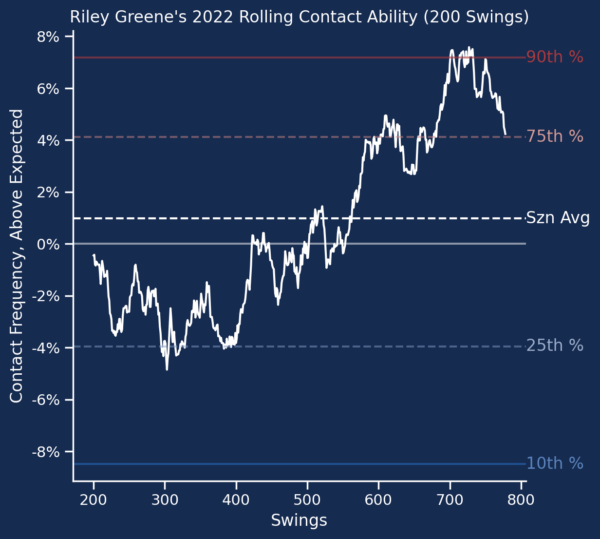
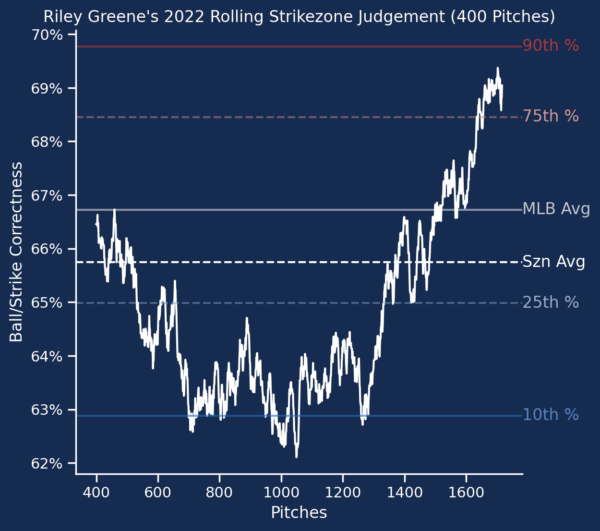
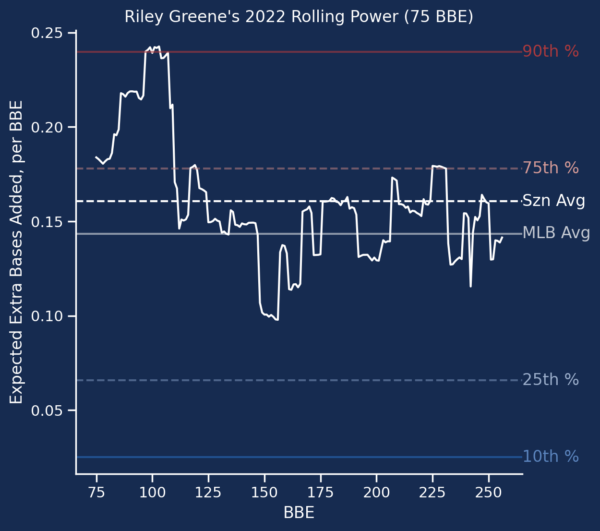
51. Andrew Benintendi (CWS), OF
When Benintendi debuted in 2016 and especially after his first full season in 2017, there was hope Benintendi could be a guy who could put up 20/20 power and speed with a high batting average for years to come. Unfortunately, the years have come and he’s never really threatened those types of numbers since 2018.
At this stage of Benintendi’s career, we have a pretty good feel for what he brings to the table—he has a solid batting average and OBP combined with barely double-digit power and speed. On the bright side, the White Sox intend to bat Benintendi second in the order behind Tim Anderson and ahead of Luis Robert and Eloy Jiménez—an ideal place for him to rack up runs and RBI with his limited pop.
Of course, this White Sox lineup isn’t exactly deep, and three of their four best hitters are rather prone to injury so that support could dry up pretty quickly if the White Sox are as unlucky as they’ve been the last few seasons. Benintendi’s probably best utilized in deeper leagues with five required outfielders as he provides an incredibly stable floor, but I could also see a situation in a 12-team league where Benintendi serves as a batting average or OBP boost for a while while you look to see what kind of ratios you can get from less-proven but higher-upside talent.
52. Michael Conforto (SFG), OF
We haven’t really seen Conforto since his disappointing 2021 season where he hit just 14 home runs and slashed .232/.344/.384 in his final season as a Met, but prior to that, he was a remarkably reliable power source who also provided a plus (or even double-plus) OBP and a neutral-or-better batting average guy.
The Giants are the ones who ultimately decided to kick the tires on Conforto to see what he may still have in the tank, and considering that the Giants are a rather savvy organization, there might still be something worth watching in this southpaw slugger. The only real downside to Conforto joining the Giants is that they’re a team that’s quick to utilize platoons and already have a legion of lefties in their batting order with Mike Yastrzemski, Joc Pederson, Brandon Crawford, and LaMonte Wade Jr. on the roster.
It’s very possible that Conforto will be platooned with a guy like J.D. Davis or Austin Slater so that the Giants can get the most out of both hitters without exposing potential weaknesses, though if Conforto shows he’s healthy and a threat to hit 25 or more home runs, I’d imagine he’d be locked into the lineup far more often than not.
53. Austin Meadows (DET), OF
Meadows was excellent in both 2019 and 2021, so it was odd to see him hit exactly zero home runs in 147 plate appearances last season. Perhaps the Rays knew that there was no more juice left in Meadows, but considering that he’s only 27 years old, that doesn’t seem terribly likely. Injuries almost certainly played a role in Meadows’ lack of power, and if there was a silver lining to the season, it was that he walked nearly as often as he struck out—a significant change from his career norms.
Whether or not Meadows retains the elite walk-to-strikeout rate doesn’t really concern me too much (as long as the bottom doesn’t fall out of either rate), and if Meadows is healthy for the 2023 season, he should be looked at as a 20-25 home run hitter with a neutral batting average and decent counting stats atop a weak-but-improving Tigers lineup. It comes with both injury risk and performance risk, of course, but catching lightning in a bottle requires a bit of boldness, and Meadows could certainly be a difference-maker if he at all resembles his 2019 or 2021 form.
54. MJ Melendez (KCR), C/OF
Melendez should never start in a fantasy outfield. As a catcher, though, he brings unique value thanks to his combination of raw power and the fact that he’s projected to lead off for the Royals. Few catchers have any chance at matching Melendez’s plate appearances if he stays healthy, and given 120-130 games, Melendez could lead all catchers in runs scored without too much trouble.
Of course, his batting average does not compare favorably to non-catchers (.217 in 2022, and likely capped around .240 or so in 2023), but his 20-23 home run power and .315-.325 OBP certainly do, and Melendez is an excellent addition to any roster where you’d rather lock in a catcher than try to play the streaming game, which is becoming more and more difficult to do as the benchmark for a starting catcher in 12-team leagues continues to rise thanks to the young talent entering the league.
55. Austin Hays (BAL), OF
It’s not exciting, but Hays should put up another season of 16-20 home runs and a .245-.255 batting average (with a low OBP due to a below-average walk rate) for the Orioles. You wouldn’t know it from his low strikeout rate (19.6% in 2022), but Hays really struggles with being overly aggressive at the plate, particularly in two-strike counts:
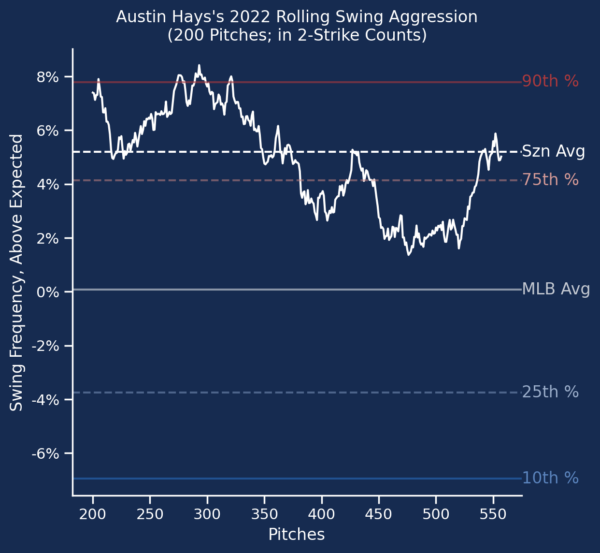
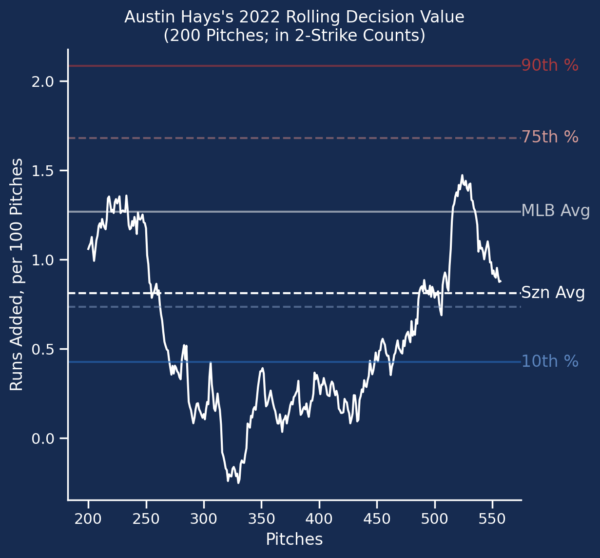
The single best thing Hays could do for his batting average and upside would be to become a bit more judicious at the plate when he falls behind, as it could eliminate a lot of the weak contact he makes (that’s why he has the low strikeout rate, by the way—instead of swinging and missing he just weakly hits balls to an infielder). That would raise his ceiling considerably, but until then, we’ve got a decent-but-flawed outfielder who will likely be on the fringe of many 12-team rosters.
56. Josh Naylor (CLE), 1B/OF
In his first sort-of full season, Naylor hit 20 home runs and drove in 79 runners with a .256 average, making him like a two-and-a-half category contributor. While a bit more playing time and health could help Naylor add a few runs scored and home runs to his totals, his high ground-ball rate, extreme aggression, and degrading strike zone judgment when he’s behind in the count (see below) have me worried that what we saw from Naylor in 2022 is about all there was to see.
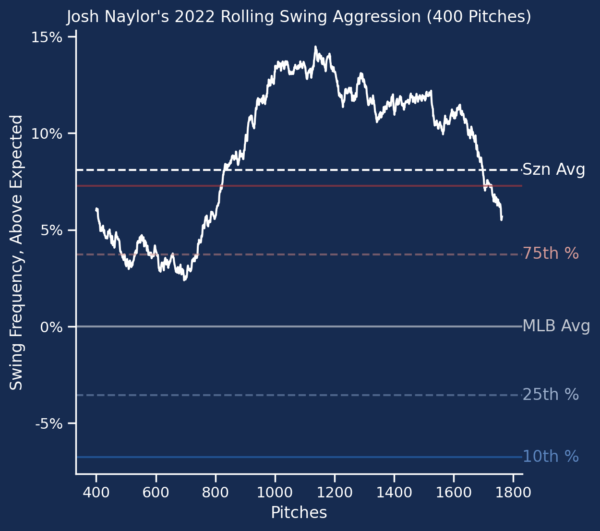
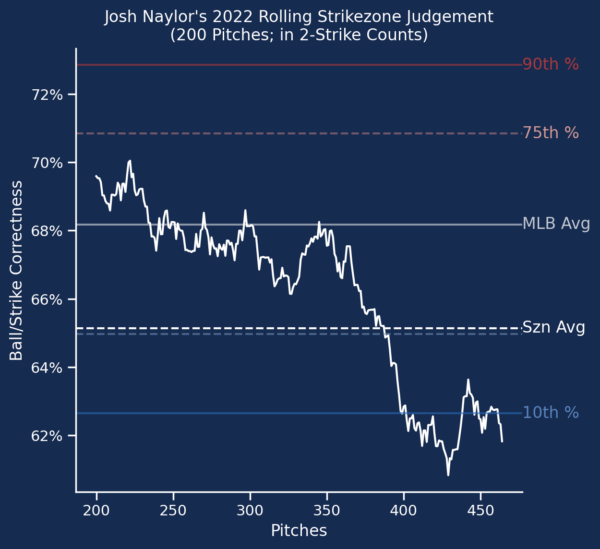
57. Joc Pederson (SFG), OF
Joc posted a career-best .274 batting average in his first full season as a Giant along with a career-best fly-ball rate and a career-best barrel rate. It’s hard to get a feel for how repeatable those levels will be for Joc in 2023, but even if they aren’t, we know his most likely outcome is no worse than a 20-22 home run hitter with a .240 batting average and a useful OBP. He doesn’t run much or do anything else besides hit 20 home runs, though if he somehow established a new baseline for himself in 2022, Joc would likely land in at least a tier or two higher than this one come 2024.
While many left-handed sluggers will benefit from the removal of the shift, it’s worth noting that Joc has greatly reduced his ground-ball rate and his pull rate over the last two seasons, which made the shift less effective on him than it would be for other lefty mashers, evidenced by the .317 batting average he posted against the shift in 2022.
Players with a track record as long as Pederson’s tend to regress to the mean more often than not, but even the mean of Joc Pederson can be a useful (if unexciting) fantasy option in the right situations.
58. Ramón Laureano (OAK), OF
Laureano has plenty of power and speed upside when he plays—he’s posted double-digit home runs and stolen bases in each of the last two seasons despite falling short of 100 games in both campaigns. Health and batting average have been highly suspect for Laurano over the last two seasons, of course, but few players at this stage of the draft have 20-home run, 20-stolen base upside, so Laureano could be worth chasing as a back-end outfielder on a team that has room to take risks. Just be ready to let him go if your IL starts to fill up while he’s on it (which he probably will be).
59. Oswaldo Cabrera (NYY), OF
Cabrera could certainly hit 20 home runs and steal 17-20 bases given a full season of work on the Yankees roster. The playing time risk is very real, though, as the Yankees have no real reason to press Cabrera into an everyday role, nor do they have a need to keep him out there if he struggles at all out of the date. On top of that, prospects like Anthony Volpe, Everson Pereira, and possibly even Estevan Florial could make pushes to join the big league club, and Cabrera’s two remaining options make him one of the easiest choices to send down to bring up one of those young players.
Watch the Spring Training position battles in Yankees camp closely, and if news beings to emerge that Cabrera could be an everyday player to start the season, go ahead and pull the trigger on him in drafts. Otherwise, he’s better left on your watchlist until a playing time opportunity opens up.
60. Manuel Margot (TBR), OF
Margot has the wheels to steal 15 bases in any given season, particularly with the rule changes coming into effect, and his batting average and OBP won’t likely crater like they would for some of the other power and speed guys in their tier. Instead, the risk from Margot comes from his health, as he’s missed significant time in both 2021 and 2022 due to injuries.
Assuming he stays healthy, Margot should have the right field job all to himself while batting somewhere around fifth or sixth, and with the lack of consistent or proven hitters behind him, the Rays are likely to give Margot the green light when there’s an open base ahead of him. He doesn’t have the upside of some of the guys in this tier, but for those looking for a source of 15-20 stolen bases that won’t come with an awful batting average, Margot could very well fit the bill.
61. Whit Merrifield (TOR), 2B/OF
I want to be more excited about Merrifield, I really do. For several seasons, Merrifield was the king of consistency—he found ways to provide an excellent batting average with tons of at-bats, hit double-digit home runs, and swipe a boatload of bases at the top of the Royals lineup. Then 2022 happened, and it felt like everything crashed. While Whit did manage to hit 11 home runs, his batting average dropped to .250 (and it would have been worse if not for a hot September where he hit .338) and he notched just 10 stolen bases, with only two of those coming in the second half and only one as a member of the Blue Jays.
While Merrifield’s ratios in Toronto were strong—he slashed .281/.323/.446 in 44 games—and he did hit five home runs (he hit just six in 95 games for Kansas City), now he’s buried at the bottom of the lineup for a Blue Jays team that isn’t nearly as aggressive as the Royals. In fact, since the start of 2021, the Royals have 80 more stolen bases than the Blue Jays (228 to 148). Heck, the Royals have 25 more steals than the Jays have attempts (203) in that span.
Merrifield’s value started with stolen bases, and with a move to a more conservative team and a move from batting first or second to eighth, it’s hard to see Merrifield clearing 20 stolen bases. Of course, a return to form could give him a shot at the top of the order and a chance to vault up into Tier 4 or Tier 5, but the floor is someone you can’t even roster.
62. Gavin Lux (LAD), 2B/SS/OF
After hitting 28 home runs across Double-A, Triple-A, and the majors in 2019, Lux was on top of the world. He was considered a top-five prospect in many circles thanks to his promising power and impressive hit tool, and there was hope that he could deliver strong performances in the big leagues as early as 2021. Unfortunately, it hasn’t yet worked out that way either in fantasy or reality, as Lux has just 18 home runs and a .253 batting average in 273 games in the majors.
While it’s still a bit too early to write the 25-year-old kid off, it’s probably safe to say that we’ve had to lower our expectations with respect to what Lux can do. On one hand, we should be encouraged by the .276 batting average and .346 OBP he had in 2022, though his numbers certainly waned in the second half. A breakout for Lux probably looks like a 15-20 home run player with plus batting average and OBP, though the counting stats may be a bit lacking unless he can pull himself out of the bottom of the batting order. That’s somewhat interesting, though the floor is a guy who struggles to hit 10 home runs, and to be fantasy-relevant with that kind of limited power you need to either pile in the runs scored at the top of the order or contend for batting titles (or in other words, you have to be Luis Arraez).
63. Randal Grichuk (COL), OF
Grichuk is a power hitter who has begun to hit for less power despite a move to the friendly confines of Coors Field. Like many Rockies hitters, Grichuk is all but unusable when he’s on the road, but when at home in Denver, he hit a very positive .307/.338/.513 with 13 home runs and 50 RBI in just 70 games.
We could probably get a little bit more out of Grichuk at home if he could get that ground-ball rate below 50% and closer to 40% like it was before he came to Colorado, and perhaps an extra year to adjust to how balls move in Coors could help him get there.
In any event, Grichuk should really only be started when he’s in Coors, and either benched or dropped when he’s on extended road trips.
64. Jesse Winker (MIL), OF
After a 110-game breakout in 2021, Winker followed it up with a dud in 2022, hitting just .219/.344/.344 (not a typo, he just had no power). With any luck, a move to hitter-friendly Miller Park and a nice change of scenery can help Winker get his mojo back, as his walk and strikeout rates remained excellent despite the rough season.
Assuming Winker looks something like the guy we saw while he was in Cincinnati, Winker could be a 22-25 home run bat with a decent batting average and a very good OBP who accumulates more than his fair share of runs and RBI in the middle of the Brewers batting order. Of course, the floor is also very low, as the Seattle version of Jesse Winker is waiver wire fodder in all but the deepest of NL-only formats. He’s worth a stash on your bench, especially in OBP formats, but you certainly don’t want to count on Winker as anything more than a fourth or fifth outfielder.
Tier 9
65. Miguel Vargas (LAD), 1B/OF
With a full-time role, Vargas could certainly be a 20-home run, 10-stolen base sort of hitter with a .260-.270 batting average, and with the Dodgers considering him for the second base job, he could pick up key eligibility early in the season.
Of course, the Dodgers still have infield options even after losing both Trea and Justin Turner, and Michael Busch could be called up at any time and take more plate appearances away, so there’s extreme playing time risk here. I like having him on my watch list if I’m doing an early draft, and if I’m drafting closer to the season, my ranking of Vargas is entirely dependent on news related to the position battles in the Dodgers’ camp.
66. Wil Myers (CIN), 1B/OF
Myers hit 17 home runs and stole eight bases in 2021 as a Padre, though he missed a boatload of time in 2022 due to injury. Myers is more of an asset in OBP leagues thanks to his usually double-digit walk rate, though leagues that penalize strikeouts will not particularly appreciate Myers’ near-30% strikeout rate. If you’re in a deep league and need a floor guy late in the draft at corner infield or outfield, Wil Myers is a guy like that. 12-team managers really can look elsewhere.
67. Joey Gallo (MIN), OF
This is a name-brand play for upside after his absolute meltdown of a season in 2022. Gallo is joining his fourth team in three seasons (which is rarely a good sign) to see if there is any hope that he can bat north of .200 or, at the very least, get his OBP back above .300 as it was prior to 2022.
The ceiling is quite high for Gallo, as he’s proven on multiple occasions that he has 40-home run power. The floor, of course, is equally low as he’s also proven he’s prone to hitting way below .200. I don’t want to call anyone washed up at 28 years old (mostly because I’m 34 and I’m not ready for that kind of truth about myself), but if things don’t pan out quickly for Gallo in Minnesota, it might be time to call it.
68. Mark Canha (NYM), OF
While his skillset is more valuable in a leadoff role, Mark Canha’s on-base skills are worth mentioning to anyone playing in points or OBP leagues as he could be a nice late-round find that helps round out your outfield. He’s not likely to bat much better than .240 or .250 nor will he hit more than about 15 home runs or so (he hit 26 once, but of course, that was in 2019), so his usefulness in standard leagues is considerably more negligible, but Canha has an OBP of .358 or better in four straight seasons, including a .367 mark in 2022.
69. Oscar Gonzalez (CLE), OF
Gonzalez is an aggressive swinger who could hit 20 home runs if things broke right in 2023, though the margin for error for him is extremely thing as he balances his extremely aggressive approach in two-strike counts as it relies heavily on his ability to recover from poor decisions by making elite contact with two strikes—something that may become more difficult as pitchers look for new ways to attack Gonzalez when he falls behind.
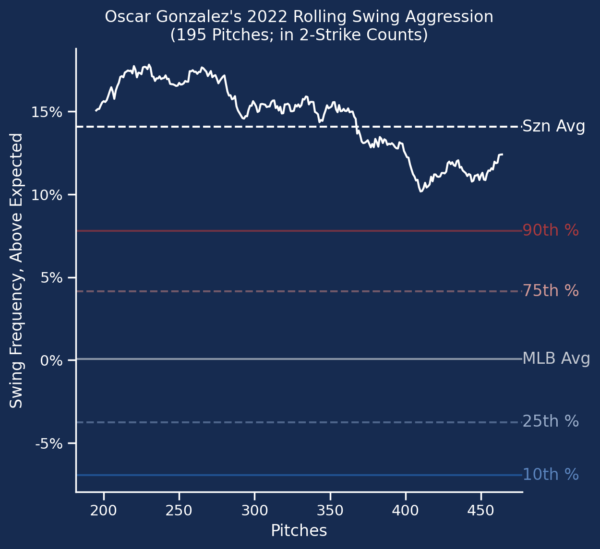
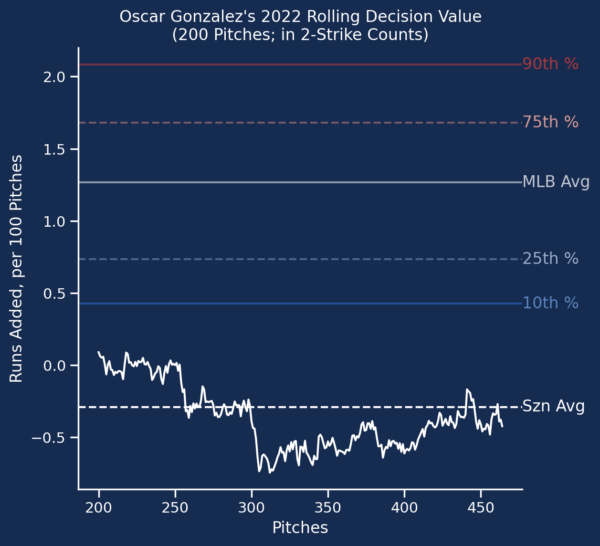
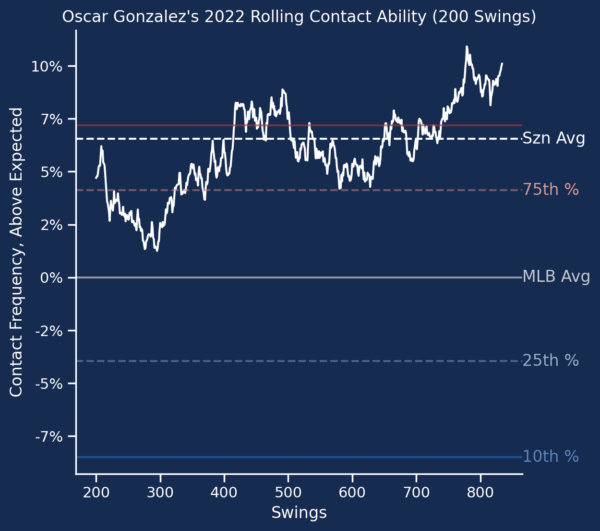
70. Lane Thomas (WAS), OF
Thomas will likely lead off for the Nationals in 2023 despite a career .237 batting average and a .314 OBP, and with all of those plate appearances, I wouldn’t be too surprised if Thomas got close to 10 home runs with 10-12 steals. Sure, they won’t come with nearly enough runs or RBI for my liking, and the ratios will be an even bigger drag than usual due to the number of plate appearances, but they’ll get there. In 15-teamers, playing time and accumulation matter. In 12-teamers, it probably doesn’t, at least not from Thomas.
71. Juan Yepez (STL), 1B/3B/OF
Juan Yepez is a slugger through and through. He pulls the ball a lot and hits a lot of fly balls, but to his credit, he also avoids striking out. Yepez mashed 12 home runs in less than half a season in his rookie campaign, and with the Cardinals, you never know when a guy might make a seemingly random leap into fantasy relevance. A full-time role is required for us to pay much attention to Yepez, but if he got one, he could flirt with 30 home runs.
Unfortunately, Yepez isn’t much of a fielder at any position, and with Paul Goldschmidt at first base, it’s basically DH or bust for Yepez right now with the current St. Louis roster.
72. Alex Kirilloff (MIN), 1B/3B/OF
I think Kirilloff could be an interesting power hitter who could hit as many as 20-23 home runs with a decent batting average, but to do it, he’ll need playing time. Trading Luis Arraez helped clear up a little bit of space, but they also went and signed Joey Gallo for some reason, once again giving them as many left-handed corner guys as a ginger has freckles between Gallo, Larnach, Kirilloff, Kepler, and Nick Gordon (though Gordon can also play a bit up the middle).
If playing time is established, I’d consider moving Kirilloff up a tier, but until then, it’s hard to get excited.
73. Seth Brown (OAK), 1B/OF
AL-only managers will appreciate Brown because he’ll play just about every day and slug his way into 22-25 home runs with 120 or so combined runs and RBI. There’s not enough ceiling to justify rostering him in most 12-team formats, though, especially with his .230 batting average, but there’s definitely power here, and if he goes on a hot streak Brown will likely be worth a stream or two, especially when the A’s draw a selection of weaker right-handed pitchers away from home.
74. Oscar Colas (CWS), OF
The international signee might just have 25-home run pop in the major leagues, but his aggression at the plate and suspect hit tool might make it tough for him to realize that power as his batting average could hover around .230 or worse if he doesn’t find ways to make contact more consistently in the minor leagues. Keep an eye on his strikeout and walk rates in the high minors (where I’d expect him to start out this season), and if they improve, be sure to keep an ear to the ground about that call-up. If the strikeout rate in the minors stays above 25%, though, you can probably move on to a new target.
75. Mike Yastrzemski (SFG), OF
Even with his double-digit walk rate, Yastrzemski just doesn’t have the pop, speed, or contact ability to provide enough fantasy juice to draft him in normal 12-team leagues, but his career .247/.334/.485 line against right-handed batters does give him some value in DFS or as a streamer when the Giants draw homer-prone right-handed pitching.
76. Esteury Ruiz (OAK), OF
If Ruiz learns how to hit, he could become an elite base-stealing threat. Unfortunately, I think he’s more of a Billy Hamilton type who won’t get nearly as many chances to lead off despite the fact that Oakland doesn’t really have anything better to do than watch Ruiz run.
77. Charlie Blackmon (COL), OF
You can stream Charlie at home against righties if you’re into that sort of thing, but otherwise, his value is limited to NL-only leagues where you need a guy who will play every day.
78. Tommy Pham (NYM), OF
If injuries or poor performance opened up playing time opportunities for Pham, he’d probably be ranked a bit higher due to his 15-18 home run power and because he has enough speed to steal 10 bases. That opportunity doesn’t yet exist for Pham, though, so I kind of just stuck him down here.
Tier 10
79. Edward Olivares (KCR), OF
The Royals just could not stop sending this guy up and down between the minors and majors in 2022, though when Olivares did play for the big league club, he hit .286/.333/.410. I could see Olivares winning a full-time job and hitting 15 home runs with 15 steals and a .260 batting average, though the more likely outcome is a part-time role that might be enough for double-digit steals and home runs but nothing more.
80. Max Kepler (MIN), OF
Remember that 36-home run season? Yeah, it was 2019, so it kind of doesn’t count. The Twins wanted to trade Kepler this offseason, but it doesn’t seem like they’ve found any suitors. A low batting average and maybe 17 home runs sound about right for the oft-injured Kepler, which might be interesting to a few AL-only managers out there.
81. Trent Grisham (SDP), OF
Grisham probably has less than one more season where the Padres will let him accumulate 17-20 home runs, 10 steals, and roughly 120 combined runs and RBI at the bottom of their lineup while he hits for a low average. If he can’t do better than than that, I’d expect him to be traded or released.
82. Jarred Kelenic (SEA), OF
I’m always willing to give an elite prospect who continues to show skills in Triple-A a chance. I might not do it in the draft, but I’m theoretically willing, at least. I’m also ignoring projections on Kelenic, because the guy they are projecting is the one who has shown up in the major leagues so far, which is not the Kelenic I’m interested in.
83. Christopher Morel (CHC), 2B/3B/SS/OF
Morel has plenty of power and speed intrigue after hitting 16 home runs and stealing 10 bases in 113 games last season, but his 32.2% strikeout rate is a tough pill to swallow. Unfortunately, Morel didn’t really get better at making contact as the season went on, and if he continues to strike out 30% of the time or more, he’ll quickly find himself riding the bench a bit too often to make a difference in 12-team formats.
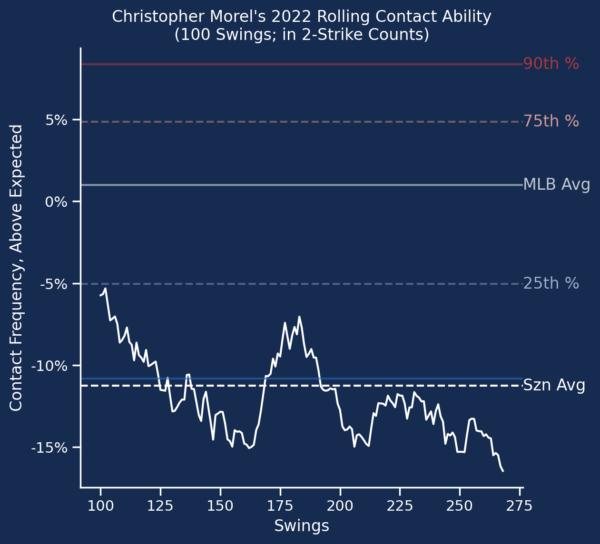
84. Jon Berti (MIA), 2B/3B/SS/OF
It wouldn’t be fair to say that Luis Arraez took his job because Berti kind of never had one in the first place. His 102 games played in 2022 were a career-high by nearly 20 games as he mostly operates as a bench/utility guy who also can run. That said, he just turned 33 and prior to 2022 he never had stolen 18 bases in any season at the big league level.
Should a couple of Marlins go down again and press Berti into action, go ahead and grab him off the wire for some steals—just don’t expect anything else.
85. Michael Brantley (HOU), OF
A walking injury risk, Brantley could still be a Jeff McNeil-type player if he somehow finds a way to be healthy in the middle of that Astro’s lineup. It’s probably more likely that he misses 100 or more games, but hey, maybe he won’t.
86. Jurickson Profar (SDP), 2B/SS/OF
If Profar lands on a team that will plug him into the top half of the batting order, he’ll jump to the top of the next tier. At the time of writing, though, Profar is without a team to call his own, and his limited skillset requires a premier spot in the lineup to be interesting for 12-team mixed leagues. Even then, though, it’s not that interesting.
87. Nick Gordon (MIN), OF
In 138 games, Gordon hit nine home runs and stole six bases. I think he has a bit more power and speed in him than that, but not that much more. In leagues where you need every plate appearance you can get, Gordon is a nice late add. In leagues where you want upside, Gordon can be left alone.
88. Garrett Mitchell (MIL), OF
Garrett Mitchell stole eight bases in just 28 games after being called up, and in a full season could maybe hit 13-15 home runs with 20-25 stolen bases. He also struck out in 41.2% of those first 68 plate appearances, though, so the performance risk is real, and with several right-handed options off the bench to spell Mitchell against southpaws, there’s very real playing time risk as well.
89. Kerry Carpenter (DET), OF
The trade with the Phillies means Carpenter looks more like a platoon player at DH than a regular, but if Carpenter were to stumble into everyday at-bats, he’d have 25-home run upside with a neutral batting average, albeit with questionable counting stats.
90. Jake Fraley (CIN), OF
Fraley is injured, like, ALL the time, but when he plays he’s shown strong on-base skills, 20-home run upside, and the ability to steal double-digit bases. He’s never even played half a season in the majors, much less a full one, but if he did somehow play that much, we’d be talking about him a lot on podcasts as a nice pick-up off the wire.
91. Adam Duvall (BOS), OF
I’m not a projection wizard but I feel pretty confident that Duvall isn’t a threat to repeat the 38 home runs he hit back in 2021. Instead, he’s probably more like a platoon guy who could hit 20 home runs if he gets hot enough, and even if he’s hot, he’s not going to bat better than .230. He’s a streamer when the Red Sox face bad left-handed pitching and nothing more.
92. Avisaíl García (MIA), OF
Injuries have always been a problem, but Avisaíl García can still hit the ball really hard, and was fantasy relevant as recently as 2021 when he hit 29 home runs and stole eight bases for the Brewers. He’s more of a target in deeper leagues where he might be able to accumulate some runs and RBI when he’s batting in the bottom-half of the Marlins’ lineup, but there are worse shots to take.
93. Akil Baddoo (DET), OF
These are MY rankings and that means I get to find a way to sneak my dude Akil Baddoo into the discussion. Baddoo could absolutely hit 15 home runs and steal 20 bases if he can recover a bit of the power and plate discipline he showed back when he debuted in 2021, but he wasn’t really able to recapture any of that magic in 2022 and the trade the Tigers made with the Phillies means Detroit doesn’t need to let Baddoo play every day unless they want him to.
94. Patrick Wisdom (CHC), 1B/3B/OF
At some point in 2023, the Pirates are going to send some bad pitchers to Wrigley who are prone to giving up home runs to right-handed batters. When that happens, Patrick Wisdom is going to be here to answer the call. He’s likely a platoon player heading into 2023, but that might actually do some good for Wisdom as he’s hit just .207 against right-handed pitching over his career.
95. Bubba Thompson (TEX), OF
Bubba Thompson could steal 30 bases if the Rangers gave him a full season’s worth of starts and a spot near the top of the order, but it would take some bad things happening for this to happen and I don’t want to think about those things.
96. Jose Siri (TBR), OF
Siri has some interesting upside as he’s consistently among the league leaders in sprint speed, and in the past has shown some decent pop. He can’t make contact, like, at all, but he’s got a ton of speed and some power, and there’s a non-zero chance you’ll stream him a few times when you’re chasing speed this season.
97. Brandon Marsh (PHI), OF
A guy who can hit double-digit home runs and steal double-digit bases is worth a fantasy conversation, and this is that conversation. He can also hit like .240 if things go right. That’s useful in an NL-only league.
98. Kiké Hernández (BOS), 2B/SS/OF
The eligibility is nice, and if healthy, Hernández should get a lot of plate appearances for the Red Sox. Granted, he probably won’t do very many exciting things with those plate appearances, but I guess he hit 20 home runs in 2021 so there’s sort of some upside if you squint at it just right.
99. Trayce Thompson (LAD), OF
Trayce isn’t really that good at making contact, but because he has power, a bit of speed, and a shot at playing time for the Dodgers, he’s worth a late-round flier in very deep formats.
100. Chas McCormick (HOU), OF
McCormick could hit 20 home runs and steal 7-10 bases if he got 150 starts for the Astros, and there are one or two possible realities where that actually happens. That said, the most realistic outcome is something like the 14 home runs and four steals he’d contributed in each of the last two seaons.
Photo by Icon Sportswire | Adapted by Doug Carlin (@Bdougals on Twitter)

Love your rankings, Scott.
Question about Grichuk. I’m in a league where it’s not possible to sit him on the road. But last year, in what was a down year for him, including his entire season (both road and home) , he was a top 40 OF. I think it’s likely this year his production is a bit better.. but even if not, why so low?
Thanks Jacstorm!
So these rankings are tailored for weekly H2H—in those leagues, you basically needed to keep an extra guy on your bench JUST because of how bad Randall was on the road (he’d crush you in those weeks). I have no desire to hold on to a guy like that, even if the overall result is a top-40 OF.
Additionally, pretty much all of that value came in two short spurts: one in April, and the one a little after the ASB. The rest of the time (May, June, September), he was atrocious.
Rostering him during those hot times is fine, but Grichuk is a total sandbag for like 2/3rds of the season.
lol Thanks, Scott. I hear ya.
Thoughts on Bryon De La Cruz?
Hey Ryan – He’d kind of be in that next tier of guys, but his overall production reminds me a lot of Lane Thomas – ok AVG, low OBP/BB%, 17ish HR power in a full season. The difference, though, is that De La Cruz will probably bat 8th or 9th on a bad team (instead of leading off like Thomas) and I wouldn’t be all that shocked if he’s the odd-man out sometimes when they want to get Berti (for speed) or Jesus Sanchez (for a left-handed bat) into the lineup. Getting beyond 120 games for him could be a challenge.
Thanks Scott
I’m returning to fantasy baseball in a 5×5 OBP league with 5 OFs. I have 4 good outfielders, 3 of whom may be injury prone (jrod, schwarber, teoscar, and Stanton), and conforto as my number 5. After that I only have Kelenic and Josh Lowe, so I need another OF.
I was thinking of picking up 1 or 2 of Fraley, Myers, Blackmon, Duvall, or Siri. Should I just take both CIN folks so I always have an OF playing?
Hey Joensuu! First and foremost, I’d wonder how many bench spots you have and whether it’s a dynasty league.
In most keeper and redraft formats, you shouldn’t need to pick up any of these guys as they should be on the waiver wire most of the season and I’d rather use that bench spot on a higher upside play or a streaming SP. If it is dynasty or you have insanely deep rosters, I think I might take my shot on Fraley, who has shown excellent on-base skills along with power and speed. Injuries have been an issue, and there’s a small chance he gets platooned, but he’s got the highest upside here. After that, I would take Myers as he’s safer and if he gets that BB% back up to 10% or so, he’ll have a solid OBP. If you JUST need power, take Duvall but the OBP will stink. If you JUST need speed, take Siri but the OBP will stink (Siri has power as well, I guess, but not like Duvall, plus the playing time is a big question mark).
Wow, didn’t expect such a thoughtful response. I’ve been posting similar questions everywhere and piecing together all the partial responses. I’ve gone from knowing about the AL East and star players to a lot of the fringe players and prospects. It’s helped me determine a rough replacement level for my starters and bench.
It is a 10T dynasty with 60 roster spots and I just dropped Bradish and a prospect for the 2 CIN guys. I drafted bradish as an upside pick late, but read here that he’d be more of a streaming option. I drafted Buehler so that will be one of my streaming spots once IR becomes available.
I was also looking at Jake Fraley’s shift stats and noticed a near 100pt woba increase in the 30% or so PA he was not shifted.
Glad I could surprise in a (hopefully) positive way! I like those moves in that context (those are DEEP rosters!), and Fraley’s upside is tied to his health but is also higher than some might realize.
Why the disclaimer on Julio Rodriguez? Either you believe in him or you don’t. You don’t leave yourself an out by sneaking in that he might flop because he’s young. Awful analysis.
Can you explain what you mean by “an out”? I did open with how I think he’s the total package and absolutely should be drafted in the first four or five picks. In my write-up for Tucker, I also point out I’m splitting hairs between the two and that Julio “can be just as good”.
If you’re asking me to be even more direct, then let me re-iterate: Julio Rodriguez is a top-5 fantasy player for me. I personally rank him 4th or 5th in the mix with J-Ram, Trea Turner, Aaron Judge, and Kyle Tucker.
Trout has a lack of power?
What do you think about Nolan Jones and Will Brennan.
Thanks for the write ups Scott. Trying to get on read on how you rank Jake McCarthy vs Seiya to help guide me as I keep flip flopping on the two… and it seems like you do too! In the top 150 you have McCarthy as 67 and Seiya as 82, but in the top 100 OF McCarthy is ranked 28 and Seiya is ranked 23…
Obviously they have different category strengths, but curious how the rankings differ between total and by-position.
Thanks!